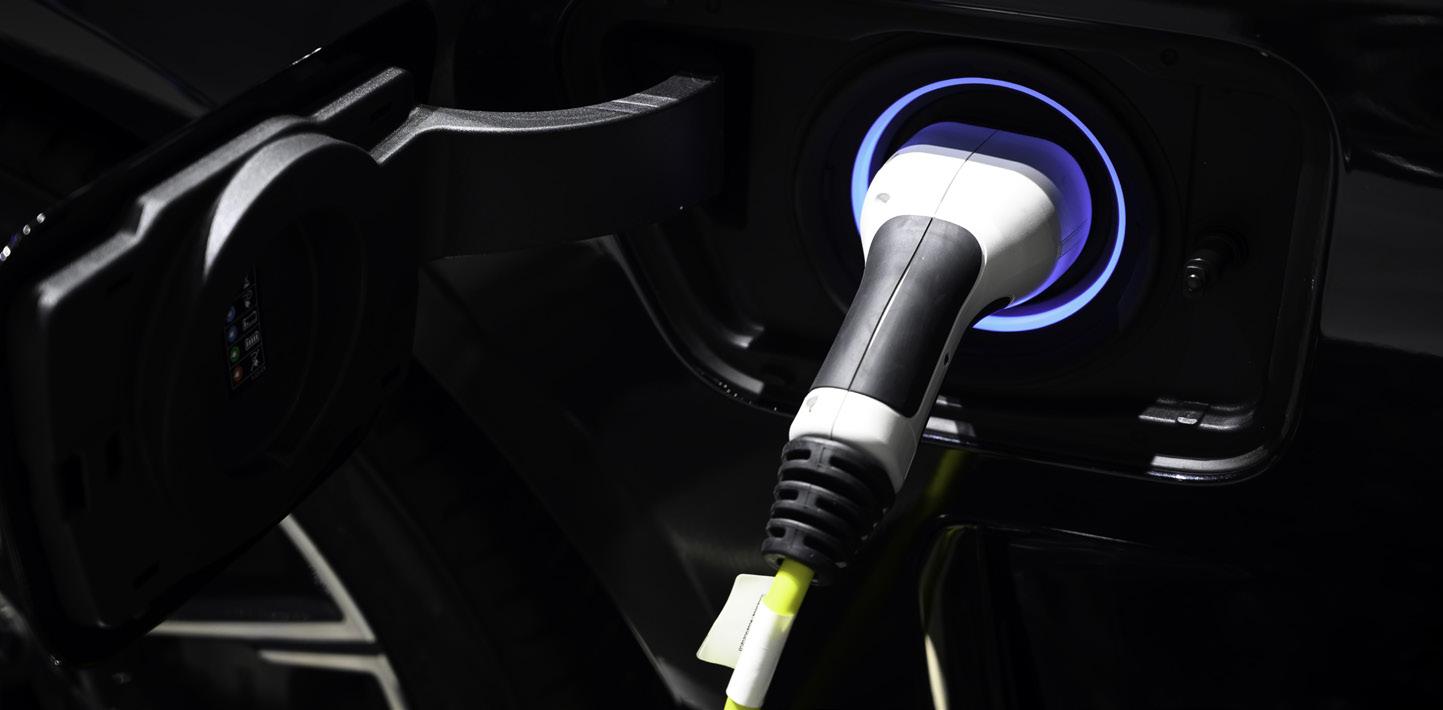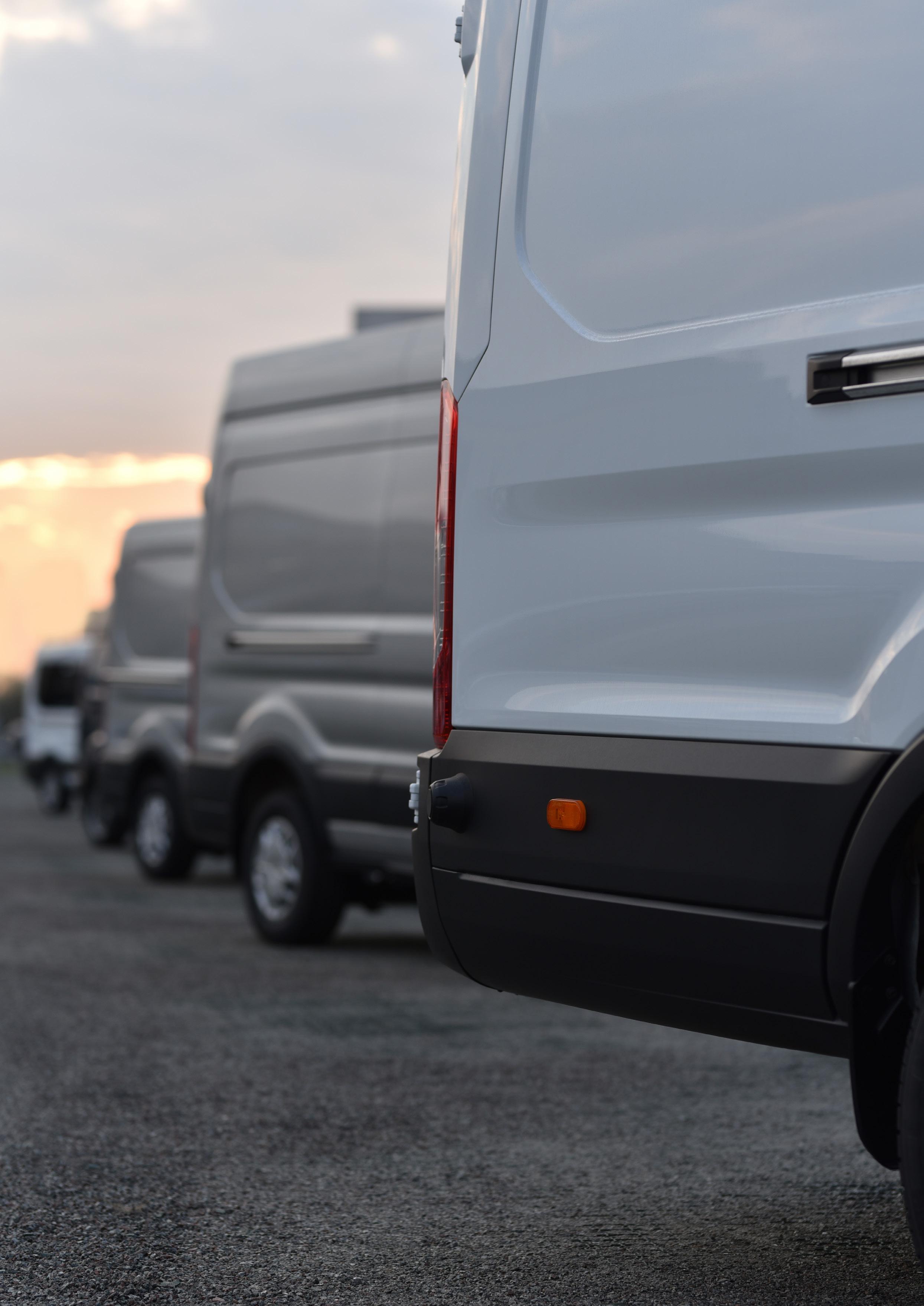





Follow and interact with us on Twitter:
@GreenFleetNews







Follow and interact with us on Twitter:
@GreenFleetNews
This issue of GreenFleet delves into the unique challenges faced by public sector fleet operators when decarbonising their vehicles.


With a diverse fleet mix, often made up of specialist vehicles, and a requirement to deliver essential services, the public sector must give careful consideration when switching to zero-emission vehicles.
To help public sector fleets, we cover the grants available to support charging infrastructure costs, whether that’s for local authorities rolling out charging in their local areas, or specifically for their own fleet.
We interview Angie Lillistone from Nottingham City Council about an innovative project which saw the council install bi-directional EV charging, solar and battery energy storage at its depot to create an energy eco-system. This approach could become a blueprint for how sites facing energy challenges can still transition to electric vehicles.
GreenFleet
Visit greenfleet.net
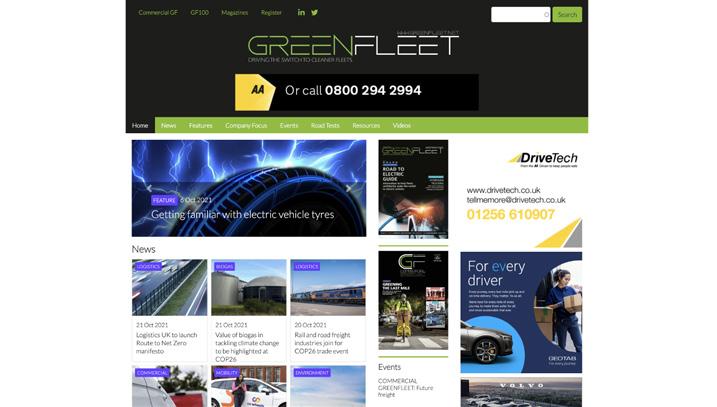
for the latest news, features, road tests and interviews
The NHS has committed to reaching net zero by 2040, and is exploring options for a complete transition to zero-emission vehicles by 2032, with the exception of ambulances which pose a particular challenge. We look at the innovation going on in healthcare fleet decarbonisation, including a trial being conducted by West Midlands Ambulance Service of the Electric Dual Crewed Ambulance.
Elsewhere, Mark Footman, CitySprint’s chief operating officer, shares his advice on creating a more environmentally-friendly fleet, following the company’s own success in this area which has helped them achieve carbon neutral status.
Angela Pisanu, editor
To register for updates, go to www.greenfleet.net/greenfleet-registration or contact Public Sector Information, 226 High Road, Loughton, Essex IG10 1ET. Tel: 020 8532 0055

GreenFleet® would like to thank the following organisations for their support:
PUBLISHED BY PUBLIC SECTOR INFORMATION LIMITED



226 High Rd, Loughton, Essex IG10 1ET. Tel: 020 8532 0055 Web: www.psi-media.co.uk
Angela Pisanu
Jo

© 2023 Public Sector Information Limited. No part of this publication can be reproduced, stored in a retrieval system or transmitted in any form or by any other means (electronic, mechanical, photocopying, recording or otherwise) without the prior written permission of the publisher. Whilst every care has been taken to ensure the accuracy of the editorial content the publisher cannot be held responsible for errors or omissions. The views expressed are not necessarily those of the publisher. ISSN 2399-4940
GreenFleet is a member of the Independent Press Standards Organisation (which regulates the UK’s magazine and newspaper industry). We abide by the Editors’ Code of Practice and are committed to upholding the highest standards of journalism. If you think that we have not met those standards and want to make a complaint please contact Angela Pisanu or Polly Jones on 0208 532 0055. If we are unable to resolve your complaint, or if you would like more information about IPSO or the Editors’ Code, contact IPSO on 0300 123 2220 or visit www.ipso.co.uk


The most cost-efficient and scalable DC charging solution on the market


Rolec EV’s latest DC ultra-rapid charging station is the most intelligent, modular and scalable solution for your electrified fleet.
The ULTRACHARGE 160 is packed with the latest charging and safety features and o ers up to 160kW charging speeds, making it ideal for fleets of all shapes and sizes.
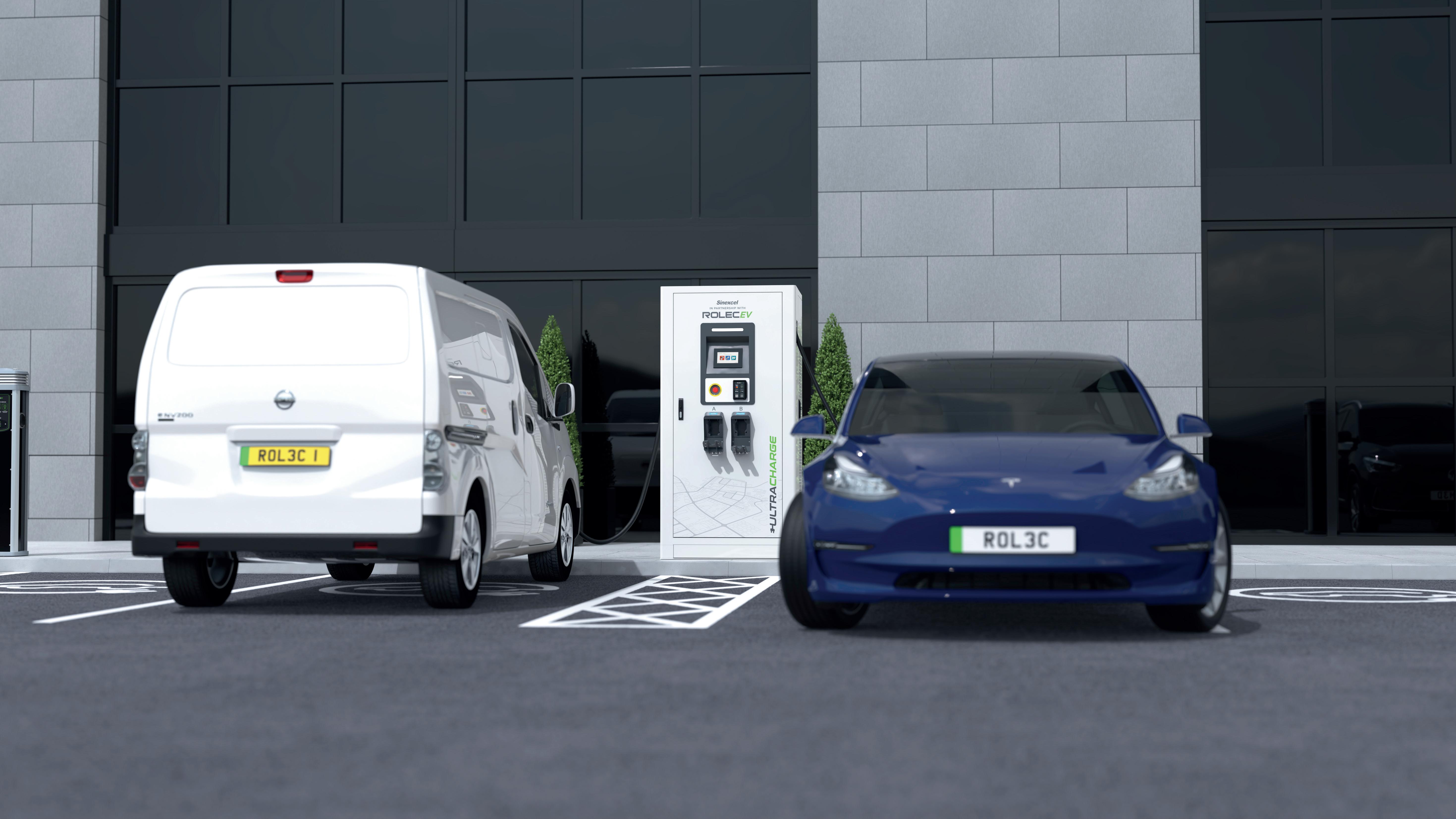


£15 million to increase electric vehicle charging points in Wales; Majority of post-RDE Euro 6 cars still over-emitting; and EV battery advances could be “double-edged sword” for fleets


Sustainability has been an important part of CitySprint’s strategy for years and the company has now achieved carbon neutral status. Mark Footman, CitySprint’s chief operating officer, shares his advice on creating a more environmentally-friendly fleet



Local authorities have a crucial role to play in enabling the transition to electric vehicles, by facilitating the rollout of chargepoints in their local areas, as well as transitioning their own fleet operations to electric. We summarise the government grants available to support this
14 Interview
A project from Nottingham City Council and its partners demonstrates how bi-directional EV charging, solar and battery energy storage can intelligently manage the energy demands caused by vehicle electrification. GreenFleet finds out more from Angie Lillistone, head of carbon reduction projects and policy at Nottingham City Council
19 Healthcare Fleets
The NHS has committed to reaching net zero by 2040, and is exploring options for a complete transition to zero-emission vehicles by 2032, with the exception of ambulances which pose a particular challenge. But these challenges are being addressed by various innovative projects and trials


The public sector is expected to lead by example when it comes to decarbonisation, but must also continue to deliver vital services without disruption. Add to this the diversity of public sector operations and vehicle usage, and decarbonising public sector fleets is a complex task. Our expert panelists unravel the challenges and offer some guidance on smoothly transitioning to zero-emission transport operations
Covering more than 1,200 miles over five days, the EV Rally will visit all capital cities of the UK and Ireland, testing the capabilities of electric vehicles and public charging infrastructure whilst visiting iconic landscapes and innovative clean energy projects
34 Roundtable: R2Z North West
There was a diverse representation of fleets in attendance at the GreenFleet Roundtable in Warrington, all experiencing their own hurdles on the road to decarbonisation. Event host Kate Armitage reflects on the discussion
36 Roundtable: R2Z East
GreenFleet’s roundtable at the Duxford Imperial War Museum on 1 June 2023 allowed local fleet operators to share their pain-points and successes regarding fleet decarbonisation
38 Road Test: Genesis GV60
Premium car maker Genesis has arrived in Europe and sets out its ground-up electric vehicle stall with the GV60. Richard Gooding finds the newcomer offers convincing comfort, luxury and technology





than 1,600 charging points – enough for one in six battery electric vehicles.
The funding will help facilitate private sector investments across Wales and ensure equality of access. To do this, the Welsh Government is setting up a private sector taskforce which will engage with the market, break down any barriers to investment and accelerate the roll out of charging infrastructure.
authorities and the private sector so that Wales keeps up with the rapid increase in the number of electric vehicles.”
Wrexham Council has received £1.86 million over two years to roll-out EV charging facilities at a charging hub in the city centre as well as sites in remote, more rural locations across the county.
The Welsh Government is set to invest £15 million to help local authorities increase the number of charging facilities across the country.
The new funding follows the £26m already invested in charging infrastructure across Wales since 2021 which has created more
Deputy minister for climate change Lee Waters said: “Drivers need to have the confidence to make the switch to electric vehicles as demand increases and that’s why we are committed to creating high quality electric vehicle infrastructure across Wales.
“The funding is another step in the right direction but we have further to go - we will continue to work with local

SUEZ has plans to build a tyre recycling plant using Pyrum’s patented pyrolysis technology which saves up to 72 per cent of CO2 emissions in the process when compared with current recycling methods.
Over the coming 12 months, the agreement with Pyrum Innovations will see SUEZ identify a location for the first plant and initiate the approval process with support from Pyrum. The planned plant will comprise three pyrolysis reactors with a recycling capacity of around 20,000 tonnes of end-of-life tyres per year.

Around 50 million tyres are disposed of in the UK, currently 13.4 million of these are used as alternative fuel, with the remaining tyres shredded and ground into a new material called crumb which is used on sports pitches or playgrounds - the rest are sent for energy recovery or to landfill.
During the pyrolysis process, tyres are separated into their component raw materials – oil, carbon black, and pyrolysis gas. The carbon black is re-used in the manufacturing of new tyres, the oil is taken by BASF and
recycled into new products and the Pyrolysis gas is used to power the plant.
Through the partnership with SUEZ, the Germany-based Pyrum Innovations AG is expanding its extensive and promising pipeline for developing pyrolysis plants across Europe.
In partnering with Pyrum, SUEZ is tapping into the UK’s recycling market for end-of-life tyres, where more than half of used tyres are currently not recycled.
SUEZ brings to the project its track record in providing resilient and innovative solutions for its customers’ waste, with its significant expertise and experience in delivering new infrastructure, from design through to operation. Elsewhere in the Group, SUEZ is innovating with pyrolysis technology in its water business, leading a research programme to evaluate the benefits of pyrolysis for treating sewage sludge to capture carbon.
Cardiff Council has received £900,000 for the next two years to roll out EV charging in the region and provide rapid charging infrastructure at Lamby Way depot for twelve electric Refuse Collection Vehicles, as part of Cardiff Council’s fleet of 78 Refuse Collection Vehicles.
Levels of air pollution in Leeds continue to decline and have not returned to prepandemic levels, new air quality data published by Leeds City Council shows.
Changing travel behaviours, a faster than average transition to plug-in vehicles, and major highways improvements are all likely to have contributed to the city’s healthier air.
Each of the city’s six designated Air Quality Management Areas (AQMAs) – neighbourhoods previously identified as being unlikely to meet clean air standards – are now compliant with national regulations and continue to improve.
As a result, Leeds City Council has announced that it plans to formally revoke five of the six AQMA designations this year. The council will keep the AQMA at Pool-in-Wharfedale under review for at least another year to be sure that recent improvements are permanent.
The plans to introduce charges in Leeds were ultimately discontinued after the majority of the city’s taxis, buses, coaches, HGVs, and private hire vehicles switched to less polluting models, leading to significant air quality improvements.
READ MORE
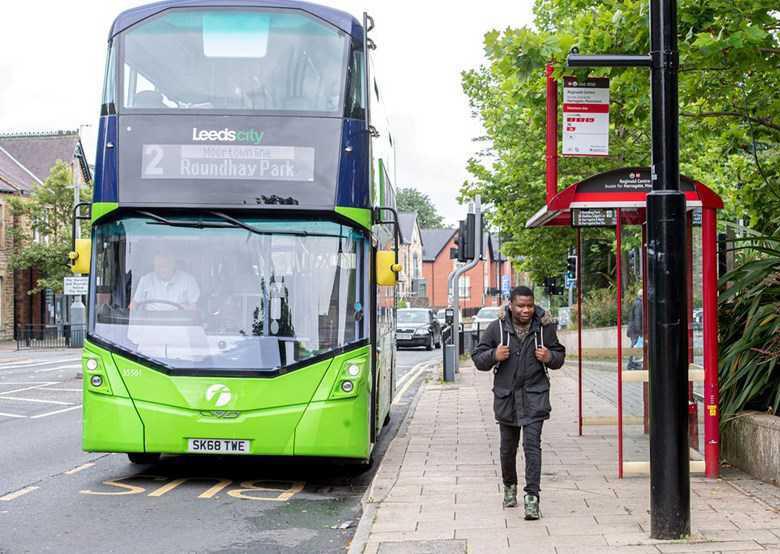
to improve without clean air zone

The testing found that light-duty diesel vehicles Euro 5 and pre-RDE Euro 6 still emit average NOx emissions 4 to 8 times higher than their respective emission standard limits, despite manufacturer software changes following the Dieselgate scandal.
The study also found that NOx emissions of diesel vehicles significantly improved, with an average 60 per cent reduction, following the introduction of the RDE Euro 6d-TEMP standard.
The majority of Euro 6 diesel cars manufactured after the Real Driving Emission test (post-RDE) are still over-emitting, despite significant improvements, warns a new report from the TRUE Initiative. The study, in partnership with Transport Scotland, analysed real-world nitrogen oxide (NOx), hydrocarbons (HC) and carbon monoxide (CO) vehicle emissions data, collected by remote sensing technology, in the cities of Edinburgh and Glasgow during October 2021.
The majority of vehicles tested were passenger cars and pre-RDE Euro 6 vehicles accounted for over 30 per cent of all measurements. The analysis identified that despite improvements, post-RDE Euro 6 cars showed variable NOx emissions performance across vehicle families, up to two and four times the laboratory and RDE type-approval limit respectively. Only a minority had mean real-world emissions below the RDE type-approval limit.
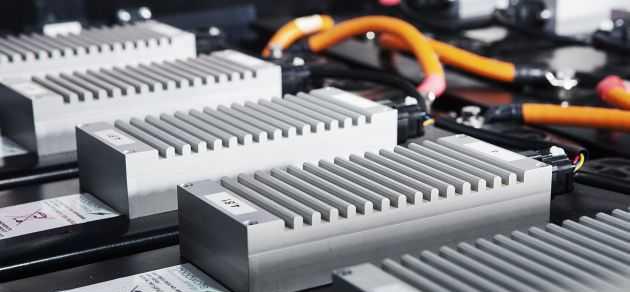
the possibility that a step change in battery technology could cause substantial harm to residual values (RVs) on existing EVs.
“This data clearly demonstrates how much progress has been made in reducing pollutant emissions across all vehicle types, but also shows where the largest emitters lie. This report provides insightful analysis which policymakers can leverage to improve air quality not only across cities in Scotland, but in other countries as well,” says Yoann Bernard, senior researcher at the ICCT and a co-author of this report.
READ MORE
Future advances in battery technology could represent a double-edged sword for fleets, FleetCheck is warning.
With recent press reports suggested that major advances could potentially be on the way, this could cause substantial harm to residual values (RVs) on existing EVs, believes Peter Golding, managing director of FleetCheck.
Peter says: “We’ve reached a stage in the last few years where any improvements in the range, charging speed and durability of electric vehicles (EVs) are generally expected to be incremental, with questions of core battery technology largely settled.
“However, it looks as though step changes might still be possible, with recent announcements on Toyota’s solid state designs, CATL talking about doubling energy density, Mullen Automotive improving battery management and more.

“On one hand, these are good news. Anything that makes EVs more practical is to be welcomed, especially in the van and commercial vehicle sector where existing technology is presenting fleets with tricky issues but it also creates problems.”
Chief among these, Peter explained was
“A manufacturer who has access to better batteries is going to want to make them available as soon as possible in order to gain a competitive market advantage but this is going to affect EVs already in use. It won’t render them obsolete but it could make them much less attractive, especially if the new tech is not just more effective but cheaper, which is conceivable.
“It’s not impossible that a business could buy 100 EVs today and then, a couple of years later, see their value dramatically affected. RVs are unlikely to collapse completely – these will still be practical, attractive vehicles for some used buyers – but there could be major reductions.
“This would have a substantial impact on leasing companies too, of course, who are already being very conservative in their EV future forecasts thanks to the quite dramatic drop in values seen over the last year. Buying EVs and bearing the RV risk remains a risky business.
“It seems to us that there is no way around this situation. EVs are still a relatively new technology in a mass market sense and step changes in technology are very much a possibility but any advances will probably be a double edged sword and fleets need to factor that into their decision making.”
READ
LeasePlan UK has launched a new dashboard timer for its EV customers to help improve wait times and driver communication at public charging stations. The dashboard timer, named ‘Happy Charger’, will encourage better charging etiquette by giving chargepoint users an easy means of telling other EV drivers how long they think they’ll be by setting an estimated time of completion using the timer wheel, which they can then display on their dashboard. The launch follows the recent move by Aberdeen and Sheffield city councils to charge drivers who stay too long in EV chargepoints. More local authorities are expected to follow suit in a bid to cut down long queues caused by the growing number of EV registrations. Commenting on the launch, Neill Emmett, head of marketing at LeasePlan UK, said: “As we learn the new process of EV charging, there are a few important etiquette rules we all need to follow, particularly when charging in public.
“Our new Happy Charger dashboard timer is all about giving EV drivers greater peace of mind when they’re out and about and simplifying the charging experience. There’s a great sense of comradery within the EV-driving community, so by adding that extra layer of transparency we can ensure we’re all being considerate of one another and enhancing the experience for all.”
All LeasePlan UK customers who lease an EV will receive a Happy Charger in their driver pack.
READ MORE
sword”
GRIDSERVE is launching a new technology division following the acquisition of Silver Power Systems (SPS), an IOT edge computing business, specialising in the technologyagnostic integration of battery data, analytics, telematics, monitoring and control systems.



Known as GRIDSERVE Technologies, the new division will be based in a new innovation and technology facility, known as the GRIDSERVE Innovation and Operations Centre (GIOC), based in Swindon.
The opening of the GIOC will give the business substantial additional capabilities, allowing it to further optimise the performance of all components of its charging networks more efficiently and accurately than ever before.
GRIDSERVE Technologies will be instrumental in driving innovation and smart connectivity throughout the company’s sun-to-wheel ecosystem, intelligently integrating solar energy generation, battery storage, electric vehicle charging and EV data into a single platform to deliver the best possible customer experience.
The technology gives
GRIDSERVE access to levels of charging, battery, and vehicle data, which it is now able to use in supporting the operations of its infrastructure and networks, including assisting in the rapid remote diagnosis of charging problems and predicting and fixing issues.
The proprietary IOT edge computing hardware together with the data available also enables the business to solve and fast-track grid connection challenges and deliver more sophisticated forms of charging infrastructure. This technology will now be accelerated at the GIOC, with the assembly of rapid deployment platforms, logistics, procurement, R&D, new product development, and interoperability testing.
Pete Bishop, CTO of GRIDSERVE Technologies, and founder of Silver Power Systems, said: “The additional resources and investment will enable GRIDSERVE Technologies to further accelerate our unique technology development to better support GRIDSERVE’s platform and our customers.”
READ MORE
20 to Zero; no not a brake test for cargo bikes, but Zemo’s view on progress to zero emission transport. After our first 20 years, it was great to see a packed house for Zemo’s 20th Anniversary Conference last week. We had some excellent speakers in a sparkling venue on a sparkling June day.
Held in the new City Hall (a building that does, quite literally, sparkle), on the banks of the Thames, it’s an exemplar of energy efficiency, and the ideal place to talk about the technologies of the future. A modern symbol of what people are capable of creating when we put our minds to it.
We were of course very glad to secure the space at City Hall to celebrate the Partnership’s anniversary on June 15 – Clean Air Day – thanks to the support of London’s Mayor. Our work on the clean air and change agendas meant the event gave us the opportunity to reflect on the progress we’ve made in both cleaning up and decarbonising the UK’s road transport in the last 20 years. I spoke about the Partnership’s ‘Top 20’ achievements which range from the agreement, design and implementation of the colour-coded ‘environment label’ which now accompanies cars on sale in showrooms (and in other contexts) to the great progress in bus decarbonisation – both via electrification and in current fuels – which we’re now working hard to emulate in powered light vehicle, coaches and trucks.
Chris Stark (the Climate Change Committee’s Chief Executive) dispelled any possibility of complacency, saying that while we’ve come some way since 2003, there’s a long and challenging hill still to climb. The Committee expects cars (around 45 per cent) and vans (15 per cent+) to comprise over 60 per cent of the emissions savings required from road transport in 2050. The contribution of HGVs is expected to kick-in harder after 2035. Significantly, Chris said that to meet the required target for 2050, car travel demand will have to be reduced by 17 per cent.
While cars and buses are, encouragingly, tracking ahead of the Committee’s ‘Balanced Pathway’ for zero emission sales, Chris’ view is that we’ve a long way to go in terms of the provision of an adequate public chargepoint infrastructure and that we need to make progress on vans and heavier commercial vehicles. Critically, we’re continuing on a long-term trend of growing car, van and commercial vehicles use while we will need to achieve the reverse. A key theme of the Anniversary Conference was that we’re coming through the ‘what are we going to do?’ and ‘how can we do it?’ phases of the transition. Broadly, we know the technologies that can get us there and what we need to get them into the market. Now is the time to ramp-up delivery of every necessary element; vehicles, chargepoints and other infrastructure, energy and behaviour change. Key to that delivery are local, regional and sub-national agencies to support the ‘bookends’ of national policy and individual action. These were represented in good numbers at the conference and amongst the speakers with two Deputy Mayors of London – for Transport and Environment – and representatives of Transport Scotland and Transport for Wales amongst others. Such organisations are now in the vanguard of the drive for ‘delivery’ and working collaboratively and in partnership with other authorities and organisations is going to be key to future success. Zemo, of course, intends to play a major convening role in this process and we took a good step forward with this Conference.
After twenty years of focus to identify the necessary pieces, we now need to put it all together within the next twenty to get to zero. All the event resources, including Chris Stark’s presentation, videos, images and a range of other resources are all being brought together on our event page: https://www.zemo.org.uk/Zemo20Zero
www.zemo.org.uk
Local authorities have a crucial role to play in enabling the transition to electric vehicles, by facilitating the rollout of chargepoints in their local areas, as well as transitioning their own fleet operations to electric. We summarise the government grants available to support this
The government’s electric vehicle strategy says that local authorities are “fundamental to successful chargepoint rollout, particularly for the deployment of widespread onstreet charging”. It says they are ideally placed to identify the local charging needs of residents, fleets and visitors.
But many local authorities face hurdles when developing of EV plans. Local authorities in the south east of England were surveyed by Cornwall Insight and the Greater South East Net Zero Hub and 53 per cent said they do not have an electric vehicle charging infrastructure strategy in place, and of these, 17 per cent said they were yet to consider developing a strategy. Cost was identified as the primary barrier to developing a plan, while grid capacity and staffing were also cited as obstacles. What’s more, just half had spoken to local residents about their EV strategy, and only 18 per cent had spoken to local businesses.
Katie Hickford, senior analyst at Cornwall Insight commented: “Local Authorites face the challenge of managing limited staff and financial resources, so must ensure the correct type of charge points are put in the locations that need it most. By engaging with businesses and residents, LAs can ensure that infrastructure meets the needs of the community, promotes the adoption of EVs, and contributes to a cleaner, more sustainable future.”
Adding to these challenges, local authorities must also transition their own fleet operations to zero-emission to meet future targets. With diverse fleets, from vans to refuse trucks and road sweepers, this is not a straightforward challenge.
To support local authorities with the EV infrastructure rollout in their local areas, as well as that for their own charging needs, there are various grants available. This includes a grant that aims to increase the capability of local authorities to plan and deliver EV infrastructure, through training and staffing.
The LEVI Fund
The Local Electric Vehicle Infrastructure (LEVI) Fund supports local authorities in
England to roll out on-street local charging infrastructure, especially to help those that cannot charge their electric vehicle at home.
The fund includes capital funding to contribute to the costs of delivering chargepoints, as well as capability funding for local authorities to employ and train new staff specifically to plan and deliver chargepoint infrastructure.
The LEVI Fund is intended to fund primarily lower-powered local chargepoints. It will cover all capital costs associated with the installation of EV chargepoints, including chargepoint hardware, electrical connection costs, civil engineering costs and other installation costs.
Rapid charging is eligible for funding as part of projects, but it’s expected that most of the funding supports delivery of lower powered chargepoints.
The deadline for local authorities to register their Expression of Interest (EOI) for funding was in May. The Energy Saving Trust, the organisation that manages the scheme, is now assessing the EOIs to determine which tranche the local authority will progress in. Its support body will notify local authorities of their tranche, and then help local authorities with the next stage of their application, which is the development of a business case.
The On-Street Residential Chargepoint Scheme, which local authorities are invited to apply for, is designed to increase the availability of onstreet chargepoints in residential streets where off-street parking is not available.
The funding is for up to 60 per cent of eligible capital costs, with total funding not exceeding £7,500 per chargepoint unless electrical connection costs are exceptionally high.
In these cases, funding up to £13,000 per chargepoint may be provided.
The remaining costs could come from chargepoint operators, if they are willing to invest capital into local authority projects which allow investment to be recovered
over time, or from local authority budgets, if, for example, the local authority is going to own and operate the infrastructure. While the scheme is primarily for on-street charging, it can be used in car parks if they are owned by the local authority. If a car park project is submitted for funding, the local authority must explain or show why they are not being installed in residential streets. The car parks must be accessible on a 24/7 basis and local residents must be able to access the car parks for free overnight between 6pm and 8am. Each chargepoint must have its own dedicated EV bay enforced by a TRO and there must have a minimum ‘maximum stay’ time of four hours during the day to ensure residents have access to a substantial charge. The scheme was recently changed to allow chargepoints to be installed on land not owned by a local authority, such as where communityowned land like village hall car parks. But this will be considered on a discretionary basis where it can be demonstrated that a lack of suitable local authority land poses a barrier to the installation of residential chargepoints. All chargepoints installed through this scheme must have a minimum payment method, such as contactless.
The capital items that are eligible for claim are limited to the purchase cost of the chargepoint up to 22 kW, the purchase cost of electrical components related to the chargepoint, including distribution network operator (DNO) connection costs, and the cost of civil engineering works related to the installation. It can also cover the labour and hardware costs of the installation, and the capital costs of a parking bay paint and signage.
The workplace charging grant Local authorities are expected to transition their own fleet operations to zero-emissions. Central government too has a target to have a full electric fleet by 2027.
To help with charging requirements, the Workplace Charging Scheme (WCS) is open to public sector organisations, as well as businesses and charities. The grant covers up to 75 per cent of the total costs of the purchase and installation of EV chargepoints and is capped at a maximum of £350 per sockets and 40 sockets across all sites per applicant. If you apply for less than 40 sockets, you can submit additional applications in the future until you reach that limit.
The aimsCapabilityLEVIfund to increase the capacity and capability of local authorities to plan and deliver EV infrastructure
These places must have dedicated off-street parking, and either own the property or have consent from the landlord for chargepoints to be installed at all the sites listed in the application.
Each site must have a minimum power supply of 3kW to each individual socket that is not diminished by their simultaneous use, and have have no more than one socket installed for each accessible parking space.
Before applying for the Workplace Charging Grant, applicants are encouraged to discuss their needs with one or more authorised WCS installers and undergo a site survey to ensure the electrical capacity of the site can support the number of sockets being applied for.
Applicants must also consider the needs of disabled drivers and drivers with reduced mobility, as well as how the chargepoint will be maintained and any associated costs. Other points to assess include how the cost of electricity usage will be covered, if or how users would be charged, and whether to make the chargepoint open for public use and, if so, whether to make the location of the chargepoint public.
If the applicant does not own or manage the land where they wish to install chargepoints, they must also secure the necessary permissions ahead of making an application.
The LEVI Capability fund aims to increase the capacity and capability of local authorities to plan and deliver EV infrastructure and to help them publish an EV infrastructure strategy for their area. Funding has been made available to county councils, unitary authorities and combined authorities, where applicable. Combined authorities will be allocated and issued funding on behalf of authorities in their region. There is a bespoke approach for London that involves Transport for London and London councils. Local authorities should identify how the resource funding can best support them to increase their capability to deliver EV infrastructure. This could mean one or multiple full-time members of staff across different roles and teams. The proposed approach should be explained in the proposal.
The Mayor of London has pledged to unlock land owned by TfL and other members of the Greater London Authority, including the London Fire Brigade, the London Ambulance Service, and the Metropolitan Police, as well partners in the NHS, to increase the density of the rapid charging network across the city.
This sees Transport for London (TfL) take public land to the private market to help bring the infrastructure needed to keep electric vehicle accessible to drivers in London.
To kick this off, TfL has awarded Zest a contract to provide and operate 39 rapid or ultra-rapid electric vehicle charging bays on public land. The charging points will be installed in 24 locations in south and southwest London by the end of 2024 including outer London boroughs such as Sutton and Bromley.
The charging infrastructure will be placed in parking bays near key routes used for essential road journeys typically made by high mileage, commercial users – including taxis and freight. L

FURTHER INFORMATION
www.gov.uk


Storm Auto Services are proud to partner with Greenfleet Magazine as we believe that the fleet industry is a sector that needs the support and protection that Storm Auto Services are already offering to service, maintenance and collision repair centres across the UK.
Through the work we do with existing fleet providers, Storm Auto Services are aware of the demands within the fleet industry. It is a fundamental requirement for vehicles to be on the road and available no matter whether it’s a fleet company car, fleet rental or a fleet delivery vehicle; vehicle off the road time will have a negative and financial impact on the fleet provider. As such, because of the offering that Storm Auto Services currently provides, we are in the strongest position to ensure that the vehicle down time is kept to a minimum. Whether it’s through our remote service where you can instantly be connected to a fully trained technician who will use the relevant OE tool to be able to fully scan your fleet vehicles to look for fault codes and then complete any technical repairs required, if new parts on the vehicle are replaced; and with modern vehicles a lot of these parts require coding or programming or whether it’s recoding a number of sensors or cameras following a collision; Storm Auto Services have the ability to support you keeping these jobs in-house; or, whether further works is required that means that the remote solution is unable to fix the problems Storm Auto Service will send a physical technician to complete the work car side.
Storm Auto Services have many years of knowledge and experience and are experts in this field and look forward to the opportunity of supporting Greenfleet Magazine partners and customers who would like to discuss this further. L

FURTHER INFORMATION
www.stormautoservices.com
The UK’s fastest growing body shop services specialists
Storm Auto Services are dedicated to supporting the fleet sector for collision repair, service and maintenance requirements and windscreen camera calibrations.

Our technicians are all fully trained and highly qualified and will support all your vehicle technology needs, either remotely or on site .
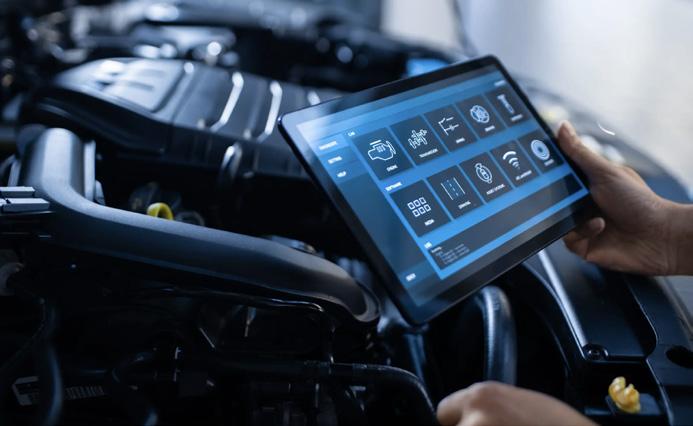
Additionally, we have a training division that helps to ensure that your staff are fully compliant with BS10125:2022.


01442 816405
info@stormautoservices.com
Storm Auto Services ensures that any vehicle problems have minimal impact on fleet operations by making sure they are off the road for as little time as possible
At Storm Auto Services, we pride ourselves on creating a unique business offering ensuring that no matter what the requirements are within the fleet industry, we can provide the complete solution to ensure that the problems that are experienced have minimal impact, therefore ensuring the vehicles are off the road for as little time as possible.
Knowledge and experience
The business has been created by two motor industry experts who bring their extensive years of experience and knowledge from within the vehicle technology and the vehicle repair industries together, meaning that no matter what problem you may face, we have the knowledge, skills, tools and training to support your needs.

Storm pride themselves on being different, the business has been built with the customer in mind using their experiences from within the industry to utilise this knowledge so that we can provide the best solution possible for which ever part of the motor industry that we work in or with. So what makes Storm Auto Services unique? Well quite simply we are the only company in the UK and Europe that provides a remote and on site solution for scanning, coding & programming of new parts and calibration of camera and sensors; plus IMI training courses up to Level 4, alongside plastic and panel repair training.
The remote service offering is an invaluable service that gives any vehicle side technician access to the right tools and technicians needed on a vehicle following a service, damage repair or new part replacement no matter what the vehicle is or what type of job is required.
The solution simply provides that technician with a generic device that can be connected to the vehicle and then the job can be sent over the cloud to the remote technician who will then connect the relevant tool to that vehicle and therefore complete any work remotely. If a remote technician is unable to complete the work, a mobile visit is required, if this is necessary then one of our trained technicians will complete the work car side using the correct tool, therefore ensuring
that the vehicle is off the road for the shortest amount of time necessary. This is one of the key benefits and something that will greatly support the fleet industry through the speed in which the work is completed, by using the remote device you get instant access to the trained technician and the correct tool for the job, however, if the job cannot be completed then a mobile technician will visit the location and carry out the work necessary the following day.
Storm strongly believes that it’s important that any remote technician connecting to a vehicle has the correct knowledge to ensure that the job is completed properly, vehicles are becoming more and more complex so it’s important to understand the vehicle as much as it is to understand the job requirements. Areas such as ADAS (Advanced Drive Assistance Systems) are really highlighting this need because ADAS calibrations are crucial for ensuring the proper functioning of these advanced safety systems in vehicles and each vehicle will have a different requirement for each calibration.
A number of vehicle manufacturers require ADAS calibrations as part of their warranty or maintenance procedures. If you neglect or improperly perform these calibrations, it may void the warranty or affect the vehicle’s eligibility for certain service
programs. Adhering to the manufacturer’s guidelines ensures that the vehicle remains in compliance and maintains its intended safety features and through working in partnership with Storm, the use of the OE tool is used to ensure that this is carried out in line with the manufacturer’s guidelines. Modern vehicles have multiple ADAS features, such as adaptive cruise control, lane departure warning, automatic emergency braking, and blind spot detection, among others. These systems often work together and share sensor data. Calibration ensures proper integration of these systems, enabling them to communicate and cooperate effectively and helps avoid conflicts or inconsistencies between different ADAS components. Another area where we leading the way is with data integrations and automations allowing for a streamlined and simple process, therefore reducing time and costs; this allows us to integrate directly through APIs into any fleet operating systems. We believe in building strong partnerships and it’s one of these partnerships with Jifeline Networks that allows us to bring to market our unique solution.
Jifeline Networks are the European leaders in the provision of remote service solutions, supporting over 100 partners across more than 25 countries who in turn support tens of thousands of customers on a daily basis; they also work with largest diagnostics companies in the world.
One of the key benefits of how the Jifeline solution supports Storm is through the ecosystem of over 350 trained technicians, all of which are available to support Storm on any job received. L

A project from Nottingham City Council and its partners demonstrates how bi-directional EV charging, solar and battery energy storage can intelligently manage the energy demands caused by vehicle electrification. GreenFleet finds out more from Angie Lillistone, head

projects and policy at Nottingham City Council
Nottingham City Council has installed bi-directional EV charging, solar and battery energy storage at its fleet depot, which is home to its 243-strong fleet. The innovative approach combines a range of technologies to overcome energy challenges, and could become a blueprint for how sites facing energy challenges can still transition to electric vehicles.
Angie Lillistone, head of carbon reduction projects and policy at Nottingham City Council, tells us more.
Please give an overview of the energy ecosystem EV charging project you have completed?
Nottingham City Council is part of the Interreg North-West Europe funded CleanMobilEnergy
pilot project. The project aimed to explore ways to reduce costs and CO2 emissions due to inefficiencies caused by the switch from traditional internal combustion engines (ICE) to electric vehicles (EV). At our Eastcroft Depot, we created a new energy ecosystem that integrates renewable energy sources, battery storage, bi-directional vehicle charging units with 40 vehicle-to-grid (V2G) electric vehicles, and an intelligent Energy Management System (called REMove). Renewable energy will be generated by the 138kWp solar array that has been installed at the depot. The projects will allow the City Council to capitalise on this locally generated energy through a variety of means.
Two giant batteries have also been installed at the depot which have a combined capacity of 720kWh. These batteries are made from 24 recycled EV batteries which have enough life to store power but are no longer sufficient for car journeys.
The V2G vehicles will be charged by energy generated from the solar panels, stored in the stationary batteries, or from the grid at times of low demand when costs are cheaper. When the vehicles return to the depot, they will be able to discharge unused energy back to the grid at peak times.
The depot will effectively be able to isolate itself from the grid during peak periods, therefore avoiding the higher peak tariffs. This whole process will be
The bevehiclesV2Gwill charged by energy generated from the solar panels which is stored in thebatteriesstationary
managed by REMove, which will allow us to better balance energy demand with supply, reducing costs and carbon emissions.
Why was it decided to approach EV charging in this way and what challenges does it address?
Nottingham has an ambitious target to become the first carbon neutral city in the UK by 2028. Transport and Energy Generation are two of the nine themes in our Carbon Neutral Action Plan. Included in our action plan is an objective to ensure that high quality infrastructure is in place to enable the transition to low emission transport. Nottingham City Council has a growing fleet of electric vehicles. More than 50 per cent of the fleet is now EV, including 20 electric refuse collection vehicles. While cities are increasingly installing renewable energy sources, there are challenges caused by a mismatch in energy production and consumption peaks.
The CleanMobilEnergy project has allowed the City Council to explore how we can better use local renewable energy to support the transition to electric vehicles. At the same time, we will also be able to better balance energy demand by using the electric vehicles themselves to power buildings on the depot.
It’s an innovative project involving many different organisations – what were the challenges whilst setting up the project?
The innovative nature of the project meant that in-depth technical knowledge was required to ensure the project ran smoothly. Extensive product research was also required to ensure that tender
documents used for procurement had the appropriate technical specifications.
To facilitate the installation of the V2G infrastructure, we were required to install a new site incoming power supply on the high voltage network and upgrade the on-site low voltage network. This was a significant piece of work which had not been anticipated at the outset of the project. The power supply to the depot was a limiting factor in transitioning the fleet to electric vehicles, so was vital to be completed, but finances had to be reallocated to complete this upgrade.
For the battery storage system, the City Council wanted to find a UK supplier with an emphasis on ongoing maintenance and warranty. We also wanted to use a less-carbon intensive product, which is why we selected an option that used second-life batteries.

Are you realising any cost and CO2 savings yet - or what are these predicted to be?
Any cost savings are difficult to quantify, as the baseline position quantified at the start of the project has changed significantly –there were no EVs in the fleet nor on-site PV generation at that time. However, savings are likely to be significant, as the system
becomes operational and is continually optimised to provide the maximum savings, in ways which were not previously possible.
What advice would you give to other public sector organisations looking to set up a similar EV charging eco-system?


Ensure your initial studies are comprehensive and reflect your needs as well as your aspirations. Survey your current fleet requirements in terms of measured operating times and distances. Then look at this, in terms of charging requirements, as if all vehicles were electric. Do you need rapid charging facilities? Can you charge using off-peak electricity?
Be aware of your current on-site electricity supply restrictions and consumption patterns – would a future power upgrade be required (even if just for export for installed generation)? Or, could site consumption be managed, using RE generation, V2G and a BESS, saving the finances required for an upgrade? L
Two giant batteries have been installed at the depot which have a combined capacity of 720kWh. These batteries are made from 24 recycled EV batteries which have enough life to store power but are no longer sufficient for car journeys
Lightbulb Analytics telematics solution is a fleet and resource management system which enables users to optimise their fleet and resources. Telematics goes far beyond just live tracking and vehicle status. Fleet managers can now easily undertake:




Telematics and fleet management data can be a game-changer for emergency service fleets. By leveraging the power of real-time data and statistical algorithms, emergency service fleets can improve more than just response times

In emergency services, time is of the essence. The faster a response team can arrive on the scene, the higher the chances of saving lives. By using telematics and real-time data, operational policing can drastically transform the way they respond to emergencies.
Using geo-fencing and the data provided by telematics dispatchers can identify the closest available emergency vehicle and direct it to the scene in a matter of seconds. This can save valuable minutes which can mean the difference between life and death.
Moreover, telematics data can be used to monitor the behaviour of drivers in emergency service fleets. With this data, dispatchers and managers can identify unsafe driving practices, such as excessive speeding or hard braking, and take corrective action to prevent accidents. This can help reduce the risk of injuries and fatalities, not only for emergency service personnel, but also for the public. A recent Lightbulb pilot showed an improvement in driver scores of over 18 per cent points in only 90 days!
This has also assisted police fleets in managing their insurance costs, by being able to demonstrate that they have an effective driver management programme in place which not only monitors, but also manages driver behaviour has led to more cost-effective premiums. It also demonstrates to insurance companies that the police fleets are using telematics data to assess improvement trends which will have a positive impact on future insurance payments.
Telematics data can also be used to optimise vehicle utilisation and lifecycle cost analysis. By tracking the mileage, fuel consumption, and maintenance schedules of emergency vehicles, managers can ensure that each vehicle is used
to its maximum potential while minimising maintenance costs. Lightbulbs’ analysis has assisted many fleets to make fleet savings of up to 20 per cent without compromising operational effectiveness through statical analysis. This can also help extend the lifespan of the vehicle, reducing the need for costly replacements. However, that is only the tip of the iceberg in which telematics can optimise operational policing. Here are some ways in which data can be used to save lives in the police force:
1. Mobilise briefing and tasking
Use telematics to automatically brief officers with crimes that have occurred in their patrol area and provides officers with the intelligence they need to be aware of during the patrol. Briefing and tasking centralises information held in several systems, so officers get ‘one view’ of emerging incidents, initiatives, and tasks. The frictionless speed of the information to the patol via an easy-to-use app means that operational police offices do not need to return to base to get updates. This increases efficiency and reduces fleet costs; some fleets saw a reduction in ‘return to base’ trips of over 50 per cent.
2. Optimise emergency responses
In emergency situations, every second counts. By using data to optimise emergency response times, police operations can save lives. For example, real-time data from GPS-enabled police vehicles can be used to identify the nearest available unit to the scene of an emergency, reducing response times and increasing the chances of saving lives.
3. Predictive policing
Predictive policing uses data analysis to identify areas and people who are at higher

risk of committing crimes or being victims of crimes. By targeting resources in these areas and offering interventions to people at risk, police departments can reduce crime rates and save lives. For example, by identifying high-risk areas for drug-related crimes, police departments can prevent drug overdoses and save lives. A pilot with a large police force saw a reduction of over 30 per cent of nuisance crimes, by redirecting patrols to hotspot areas.
4. Intelligent data sharing
Police departments can save lives by sharing data with other agencies, such as fire departments and emergency medical services. By sharing data on emergency calls, police departments can ensure that emergency responders arrive at the scene of an emergency as quickly as possible, increasing the chances of saving lives.
5. Integrated AI dashcams
The use of Integrated dashcams is currently in development. This will assist in insurance claims by providing video and image capture to reinforce the incident data recorder data currently available. It can also be used to provide real-time video streams to force control centres so enabling control room supervisors to have a ‘real life’ view of incidents as they unfold. In comparison to using a police helicopter which can cost over £2,000 per hour, this is a very cost-effective way for managers to review ongoing incidents. In conclusion, the use of telematics and fleet management data can be a game-changer for emergency service fleets. By leveraging the power of real-time data and statistical algorithms, emergency service fleets can improve more than just response times, optimise vehicle utilisation, and decrease costs; it will further improve public safety and save lives. L


The NHS has committed to reaching net zero by 2040, and is exploring options for a complete transition to zero-emission vehicles by 2032, with the exception of ambulances which pose a particular challenge. But these challenges are being addressed by various innovative projects and trials
NHS travel and transport is estimated to account for 3.5 per cent of all UK road traffic, and is estimated that decarbonising the ambulance fleet could potentially reduce emissions by 87 ktCO2e every year. With an overall goal to be net zero emission by 2040, the NHS in England has set itself interim targets to decarbonise. And while some of the NHS fleet can transition to zero emissions relatively easily, others, such as ambulances, have challenges that need to be overcome first. These vehicles are needed to save lives, and are required to travel at high speeds to get to emergencies. They therefore cannot afford the downtime from charging. The weight of the vehicles, plus the need to power high levels of equipment, adds to the electrification challenges.


Electric ambulance trial
West Midlands Ambulance Service is trialling an electric ambulance known as the Electric Dual Crewed Ambulance (E-DCA) by conversion specialist VCS. The ambulance is powered by lithium-ion batteries, which are situated in the underside of the ambulance floor pan in a specificallydesigned and compliant enclosure, ensuring it has a low centre of gravity. It has a power output of 129bhp (96kW), a top speed of 75 mph and can achieve a range of 105-110 miles with a recharge time of 4.25 hours.
The ambulance includes a number of design elements
that ensure it is as versatile and usable as possible. These include rear door damp assist systems, hospital chair gangway accessibility, intelligent run lock management, and an OLED graphical HMI keypad.
London Ambulance Service has made significant inroads in the decarbonisation of its fleet.
As well as having three electric motorcycles on the fleet, and a number of hybrid vans and plug-in hybrid cars, London Ambulance Service has recently taken on a fleet of electric Mustang Mach-E cars for its Fast Response Unit. Seven of the E
West Midlands ServiceAmbulance is trialling an electric ambulance known as the Electric Dual AmbulanceCrewed
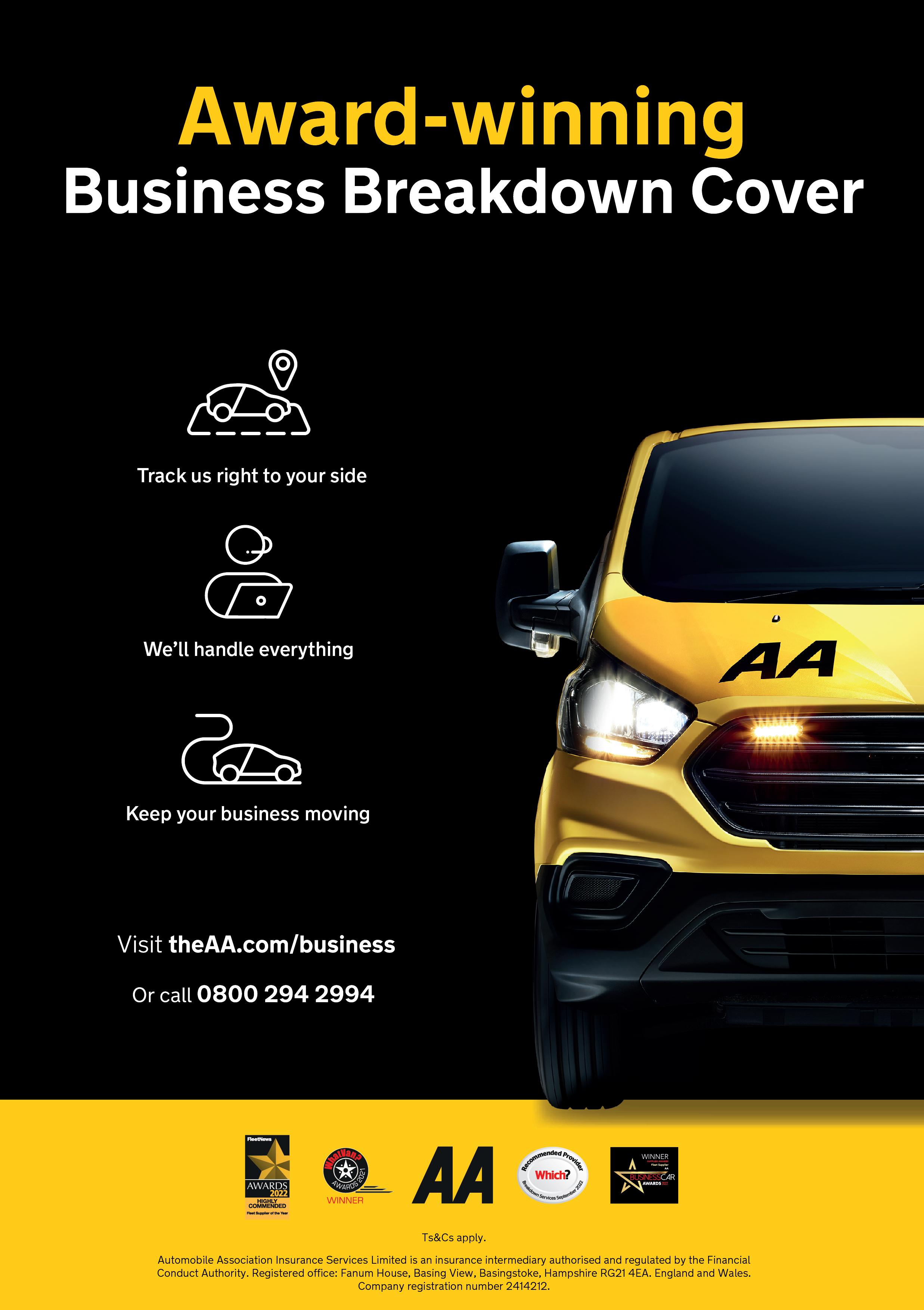
cars are already in use with a further 35 being delivered over the next few weeks.

It takes just 40 minutes to charge the Mustang battery to 80 per cent and that allows the car to travel more than 300 miles, which is about ten times further than an ambulance would normally cover on a shift.
The blue lights and sirens are powered by a 12-volt battery rather than the car’s drive battery but the Service is fitting solar panels to the cars to make them even more environmentally-friendly.
As part of a £31 million investment programme, the Service is also investing in charging infrastructure across its sites and ambulance stations, as well as recruiting new mechanics and upskilling current mechanics to help maintain its growing modern fleet.
London Ambulance service has also taken delivery of nine brand new bespoke ambulances which are lightweight, greener and more efficient than the Service’s current ambulances and meet the clean air zone targets in London.
The MAN ambulances are replacing older vehicles in the fleet and were designed after consultation with frontline crews to ensure they are suitable for the demands of caring for patients in the capital.

A further 11 MAN ambulances and 112 ambulances have been ordered, and four fully electric ambulances are expected to be delivered to LAS later this year.
The world’s first hydrogen fuelled ambulance, created by ULEMCo, was unveiled at COP26 in Glasgow in 2021.
Named for Zero Emission Rapid Response Operations ambulance (ZERRO), the vehicle has a hydrogen fuel cell range extender with
an electric drive, a low frame chassis and a bespoke lightweight ambulance body, with a range of 300-miles. Specific features such as the low access floor and a frame-based body enable it to meet the payload requirements of the health service, and the hydrogen fuel cell ensures fast and flexible refuelling.
ULEMCo has recently been awarded £3.9 million by government, matched by industry to a total £7.9 million, for a major project with its partners to develop solutions for hydrogen powered vehicles. The ‘HYER Power’ project will develop a hydrogen fuel cell range extender module that will integrate into electric vehicles used for specialist applications such as ambulances, fire engines and street sweepers.

Key outcomes of the project will include a production-ready zero-emission ambulance as a result from the work already completed by ULEMCo under the ZERRO project.
South East Coast Ambulance Service NHS Foundation Trust is to trial three fullyelectric Mercedes-Benz e-Vitos as Single Responder Vehicles later in 2023.
The vehicles will initially be based out of three Trust sites where heavyduty vehicle chargers are installed – Polegate, Thanet and Gatwick. The chargers will be able to charge the vehicles in as little as 30 minutes.
As charging infrastructure is developed across the Trust’s sites, it is hoped the vehicles will be tested in other areas to gather wider feedback from staff.
In addition to its traditional ambulances, South East Coast Ambulance Service NHS Foundation Trust currently operates a fleet of 118 SRVs, which is made up of a
majority of diesel vehicles as well as 15 hybrid petrol Mitsubishi Outlanders. The Trust will provide feedback to NHS England and gather information on the use of the vehicles for future developments.
Eight ambulance trusts are trialling 21 zero-emission vehicles of various types, with six of the new green vehicles dedicated to mental health response in the community – designed to cut emergency response times for people with mental health needs and help reduce demand on traditional double-crewed ambulances. The dedicated mental health response vehicles, which are already in action in the North West, differ in design from traditional ambulances – while they still carry the equipment which enables them to respond to the most serious life-threatening emergencies when required – they have fewer fluorescent markings and a much less clinical interior to help put patients at ease.
The all-electric vehicles can be deployed as a rapid response vehicle when someone is experiencing a mental health crisis, providing a safe space for healthcare workers to support patients with mental health needs. Other vehicles in the new green fleet include those equipped to attend less severe emergencies and those designed to transfer seriously ill patients to and from high dependency units – helping to relieve pressure on traditional ambulances and ensure patients get to the right location for the right treatment. L
The public sector is expected to lead by example when it comes to decarbonisation, but must also continue to deliver vital services without disruption. Add to this the diversity of public sector operations and vehicle usage, and decarbonising public sector fleets is a complex task. Our expert panelists unravel the challenges and offer some guidance on smoothly transitioning to zeroemission transport operations

Steve Beadle is head of 0Zone, the Grosvenor Group’s innovative and market leading solution to help companies navigate their way smoothly towards ultra-low emission and electric vehicles. Steve joined the Grosvenor Group in 2012, and is well-known for his clear and inciteful advice for companies with car and light commercial vehicle fleets looking towards their zero emission futures.

Laura specialises in helping fleets transition to EV charging payments simpler and more efficient than ever. Her global role means she builds local, meaningful partnerships in order to achieve this.
Fleetcor’s portfolio of brands automate, secure, digitise and manage payment transactions, helping fleet operators manage their mixed fleets in their transition to EV.

Simon West-Oliver has over 30 years of experience in the fleet industry. He pioneered some of the early telemetry solutions as well as launched several software solutions to help organisations acquire, manage, maintain, and dispose of fleet assets in a timely and efficient manner. Simon’s wealth of experience supports fleets in managing their assets by providing sustainable change with decarbonisation planning, digitalisation in workshops, embracing a circular economy and managing environmental and social compliance.
The public sector is expected to lead by example when it comes to decarbonisation. Starting from the top, central government has a target to decarbonise the entirety of its central car and van fleet to zero emission vehicles by 2027.
Local authorities have the double challenge of having to decarbonise their own transport operations, and making their own local areas EV-friendly, by way of installing electric vehicle charging infrastructure and developing other incentives to promote adoption.
Other vital areas within the public sector, such as healthcare and emergency response teams, must also decarbonise. Needless to say, these have their own unique challenges that require careful consideration.
Steve Beadle, Grosvenorhead of 0Zone at The
Group says: “Public sector bodies
have a very diverse and wide range of vehicles, making their move to electric quite complex, and their actions are under far greater scrutiny than the private sector due to it being taxpayers money. If we look at the full breadth of public sector vehicles, it ranges from staff providing care in the community and driving small cars to people’s homes, through to refuse collection vehicles and other electric HGVs. Then if we expand it further, we are looking at the emergency services, with the Police having an enormously diverse fleet mix, the ambulance services and the fire brigade.
“On the one hand, the public sector is expected to lead by example by having a zero emission fleet, particularly in large towns and cities where private motorists and businesses are being penalised for
having higher emission vehicles, for example through low emission zones.
“But on the other hand, the public sector is also under huge pressure to meet its obligations to providing public services, and this can become more challenging when transitioning to electric. If we look again at how diverse public sector fleets are, it is relatively straightforward for someone providing care in the community, driving relatively low mileages every day, to move to an electric car. However that is a very different scenario to a heavily armoured police vehicle responding to emergencies.”
Summing up the challenge, Steve says: “It isn’t just about finding suitable vehicles to enable public sector bodies to continue to meet their obligations with zero emission motoring, it is also about the charging
infrastructure, managing public expectations, balancing the public purse, and implementing a change programme whereby public sector employees, especially in critical services, believe that they will be able to do their job in an electric vehicle when they have been used to driving a petrol or diesel for so many years.”
Laura Lancaster, vice president of EV Networks & Partnerships at Fleetcor, the company that owns AllStar Business Solutions, agrees that diversity of public service operations makes a one-size-fits-all solution for decarbonisation difficult. Laura says: “The public sector covers a huge variety of fleets and departments; ranging from company cars, vans for NHS transport, blue light ambulance services, police services, to local council service vehicles such as refuse, waste management and speciality environmental agency vehicles. All of these fleets are used in a different way, some required 24 hours, some travel large distances across counties and some in urban areas. The type of specialty equipment and the energy to power the equipment varies as well when looking at fire services, ambulances and heavy duty vehicles. Essentially, fleets have to be fit for purpose to deliver their essential services – impact on service and down time is not an option for some of these fleets.”
Another problem is the often disconnected nature of public services. Laura explains: “Another challenge is the fragmentation of each part of the public sector, with the variety of services they conduct. It’s also tricky pinpointing where the responsibility lies within each service. Is it the facilities and estate, the fleet manager or human resources? With our own public sector customers, we are working with them to help deliver a standardised solution over multiple sites in the same trust or county which have historically implemented different charging infrastructure. The “fragmented” approach is later causing challenges to managing the infrastructure across sites, as well as consolidating costs and the consumption of the electric vehicles deployed.”
“Public sector is also dealing with limited budgets an staff and drivers under strain. They are more scrutinised when it comes to spend and KPIs – all which will be impacted by decarbonisation initiatives,” Laura adds.
Fit-for-purpose above all Simon West-Oliver, director of sales, AssetWorks agrees that the diversity of public sector fleets and their vital nature means that decarbonisation can be problematic. He says: “Public sector fleets are responsible for delivering essential services, such as emergency response, waste management, and public transportation. These services often require specialised vehicles with specific capabilities and equipment. Decarbonising these specialist vehicles can be challenging, as alternative fuel options may not yet be readily available or suitable for their specific functions. Finding suitable decarbonisation solutions that maintain the functionality and effectiveness of these vehicles is a key challenge.”
The public sector generally faces funding conflicts, as Simon points out: “The public sector often operates within constrained budgets, and fleet decarbonisation efforts must compete with other funding priorities. The higher upfront costs associated with purchasing or transitioning to low-emission vehicles can pose financial challenges. Limited budgets may slow down the pace of fleet decarbonisation, requiring careful planning and exploration of funding options or grants to support these initiatives.
“What’s more, public sector spending is subject to scrutiny and accountability. This means that every investment in fleet decarbonisation must be justified and demonstrate clear value for money. The need to balance the environmental benefits of decarbonisation with the financial implications can make decision-making more complex and require robust business cases and performance evaluation.”
Infrastructure issues could also be a barrier for the public sector: “Public sector fleets often require dedicated or specialised infrastructure, such as charging stations for electric

vehicles or hydrogen refuelling stations. The availability, accessibility, and cost of such infrastructure can impact the feasibility and pace of fleet decarbonisation,” Simon says. But these challenges can be overcome with the right approach and the right support.
Simon says: “Addressing these challenges requires a holistic and tailored approach that considers the specific needs of the public sector. Collaboration between fleet managers, government agencies, industry experts, and technology providers is essential to overcome these obstacles. Innovative financing mechanisms, partnerships with private sector stakeholders, and continuous monitoring and evaluation can help the public sector navigate the challenges and successfully decarbonise their fleets while delivering essential services to the community.”
So how can public sector organisations begin with their fleet decarbonisation in a way that deals with these aforementioned challenges? When it comes to avoiding downtime from charging an electric vehicle, something that many public sector fleets cannot afford, Laura Lancaster from Fleetcor / Allstar says that there are various strategies and not one solution fits all: “Buses could charge overnight, for example, and others could charge between jobs or in natural downtime, such as while ambulances are waiting at A&E,” suggests Laura. “Using rapid networks, such as Allstar’s where there are 3,000 rapid charge points, can also help avoid downtime,” she adds. Choosing vehicles with a large range or vehicles with a battery that charges quickly is also advisable. Laura shares an example: “Electric Ford Mustang Mach-E cars are being used by the London Ambulance services for paramedics responding to 999 emergencies. It’s reported that the battery takes just 40 minutes to charge up to 80 per cent which allows the car to travel more than 300 miles, which is about ten times further than an ambulance would normally cover on a shift.” E
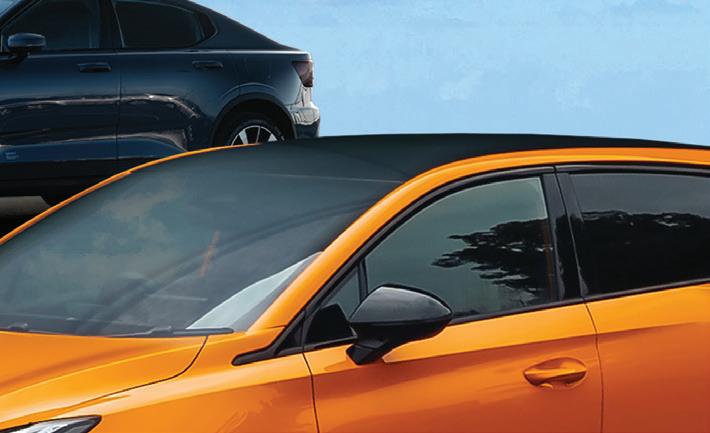

Grosvenor Leasing’s Salary Sacrifice scheme for Ultra Low Emission Vehicles and Electric Vehicles


can save your employees as much as 40% per month compared to a personal lease, with financial and environmental advantages for your business too.

It also comes with protection against employees leaving the company, or going on extended sick or maternity/paternity leave, and there is minimal input required to put it in place.
It means businesses can implement the scheme with complete peace of mind, and without being overwhelmed with lots of administration.
For more information, why not speak to one of our Ultra Low Emission and Electric Vehicle Salary Sacrifice experts







Employees sacrifice a portion of their gross salary in return for a fully maintained, taxed and insured company vehicle, at very competitive rates.
The employer gains by making Class 1A National Insurance savings as well as offering an additional staff benefit, at no extra cost.
With many exciting electric cars available, such as the MG4 EV, Cupra Born and Polestar 2 (all shown above), now is a great time to be offering a ULEV and EV Salary Sacrifice scheme.



Telephone 01536 536 536 or email
salsac@grosvenor-leasing.co.uk

Selecting the vehicles that could easily switch to electric is a good way to kick off decarbonisation plans, says Laura. These could include company cars, salary sacrifice, non-essential services in the emergency sector, electric street sweeper, electric vans for services, and so on. Telematics is a good way of identifying which vehicles to transition.”
Another way to start the decarbonisation journey is to work with industry to build and trial zero-emission transport solutions, believes Laura. West Midlands Ambulance Service, for example, is trilling an all-electric ambulance, known as the Electric Dual Crewed Ambulance (E-DCA), in front-line services.
Careful planning
Steve Beadle, head of 0Zone at The Grosvenor Group says that the level of scrutiny the public sector is under adds another pressure to fleet decarbonisation. As such, it’s vital to have a clear strategy. Steve advises: “It’s important to map out all of the vehicles, and look at where they are driven, what kind of activity they are undertaking, what charging infrastructure is either in place now or being developed, and can they be replaced by an electric vehicle, and over what time frame.
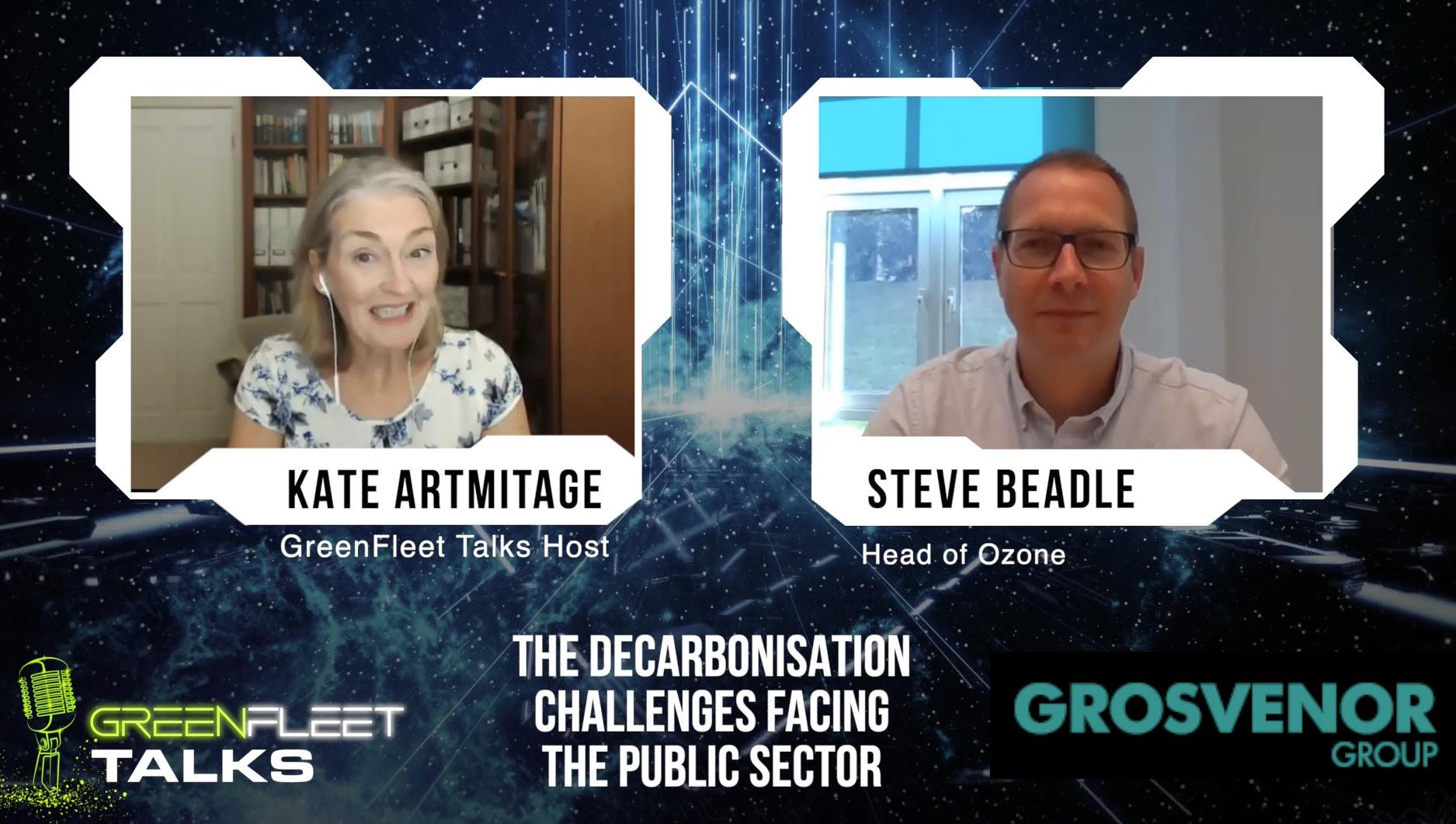
“By doing this, an EV switch programme can be mapped out ranging from the quick wins, where the conversion to electric is relatively simple, through to the more challenging where the move to electric is far more difficult.”
And don’t be afraid of a gradual transition, Steve says: “A wholesale move to electric might not be possible, and it is important to identify which vehicles can become fully electric, and which vehicles cannot.”
“Where full electric is not feasible, perhaps due to the mileages being driven, the type of vehicle required, or there being a lack of suitable electric models available, a hybrid model or low emission petrol or diesel might be the interim solution.
“Flexible leasing is far more available nowadays, and there should be no reason why a public sector body couldn’t negotiate some form of short term lease on ultra low emission vehicles while waiting for an electric alternative to become available - rather than having to commit to another three or four year lease.
“Another option, which is something Grosvenor has done in the past, is agree as part of a contract hire arrangement that if a suitable electric vehicle becomes available, the current lease arrangement can be terminated without penalty to facilitate that move to an electric vehicle more quickly.”
Ask the right questions
When switching to EVs, very careful planning is needed, and every single vehicle needs to be mapped out, advises Steve. So what questions should be asked? Steve suggests the following: What does that vehicle do? Over what geographical area does it operate? What is the charging infrastructure in that area? What is the availability of suitable electric vehicles? Is there any way the use of that vehicle can be changed to accommodate an electric vehicle or does an electric vehicle need to perfectly meet the requirements of that job role?
Other questions to ask are: What type of loads does the vehicle carry? When does the lease contract come to an end? Who is driving the vehicle and what actions need to be taken to educate them about doing their job in an electric vehicle? How resistant to change will they be? If it is a shared vehicle, how will that be managed in terms of usage and charging? To what extent can charging be carried out at work, using public charges or at employees’ homes? If drivers are using their own vehicles for business use, what can be put in place to encourage the conversion of that fleet to electric?
“It is questions such as these that need answering as part of an EV transition strategy,” says Steve.
Understanding your fleet
Simon West-Oliver from AssetWorks advises that to avoid decarbonisation pitfalls, it’s essential first to understand duty cycles. He explains: “Conduct a comprehensive analysis of the duty cycles and operational requirements of the fleet. This includes assessing vehicle usage patterns, mileage, payload capacity, and specific functions. Understanding these factors will help identify which vehicles are best suited for early-stage decarbonisation and prioritise efforts accordingly.
“Research and leverage available funding options to support fleet decarbonisation. Governments and organisations often offer grants, incentives, or financial programs specifically for transitioning to low-emission vehicles. Identifying and applying for these opportunities can help mitigate the financial burden of adopting cleaner technologies.”
Careful consideration of charging requirements is also vital. Simon says: “Evaluate the charging infrastructure needs for electric vehicles (EVs) in the fleet. Consider factors such as on-site charging stations, high-power charging capabilities, and the availability of public charging infrastructure. Developing a charging infrastructure plan that aligns with the fleet’s operational requirements will ensure reliable charging access without disrupting essential services.”
Other advice offered by Simon is to consider taking part in pilot projects and trials, and
collaborating with industry experts, who are happy to offer support. Road maps and targets also help focus mindsets and accelerate plans.“Create a comprehensive roadmap for fleet decarbonisation that includes specific targets and milestones. This roadmap should consider the unique characteristics and challenges of the fleet, along with potential technological advancements and infrastructure developments. Setting clear targets and tracking progress will ensure a structured approach and maintain momentum towards achieving long-term decarbonisation goals,” Simon from AssetWorks adds.
Eliminating grey fleet
Many public sector employees use their own cars for business travel, which is known as ‘grey fleet’. Grey fleet vehicles tend to be older, more polluting, and may not be serviced as regularly. It can be difficult to supervise them too. With recent travel disruption, such as train strikes, more drivers may be drawn to using their own car for work.
So how can the public sector reduce this reliance on ‘grey fleet’? Laura Lancaster from Fleetcor / Allstar, says: “Grey fleet may be one of the hardest areas for the public sector to decarbonise. Grey fleets have always accounted for a large portion of the NHS travel with district nurses, health services using private vehicles for work travel.
“If the NHS, for example, continue to have grey fleet, they are reliant on employees to change their vehicles ahead of time to meet the decarbonisation measures. Salary sacrifice schemes are widely encouraged in the NHS, but is the incentive enough for the health professionals to switch, especially when pence per mile schemes are well paid in ICE vehicles.
“A change to company car fleet would be the most effective way to do this, but this does come with budgeting consequences for Trusts. The solutions for company car drivers has been tried and test by the private sector, with a solution like what Allstar offers for businesses to pay for their electric charging on-the-road via a single card and their home charging directly through the drivers energy supplier so staff are never out of pocket. E
Enjoy fast, rapid or ultra-rapid charging on 98% of our network.

Whether it’s local deliveries or long-range journeys, we’re here to keep your drivers and your business powered up for the road ahead.
Allstar One Electric. Got yours yet?
Allstar One Electric
“Sustainability reporting may bring the change from grey fleet to company cars into fruition in future years - with the inclusion of grey fleet in those numbers and as the targets and commitments dates’ drawer closer.”

Laura also points out that much of the NHS is encouraging other mobility solutions and active travel for their staff, such as pool e-bikes, walking, cycling, and public transport.
Adding to this advice, Steve Beadle from The Grosvenor Group says: “The implementation of an electric vehicle salary sacrifice scheme is something public sector bodies should be looking at. This is by far the cheapest way for a driver to fund an electric vehicle as it is up to 40 per cent cheaper than a personal lease. That should not only just be put in place, but also promoted and communicated widely across the public sector body to maximise the uptake with employees.
“Car sharing schemes are also a good way of reducing the use of grey fleet vehicles. This can either be an in house operated scheme, whereby an ultra low emission or electric pool fleet is used by employees for occasional travel. Alternatively public sector bodies could sign up to a managed scheme of car sharing.
“Mobility as a solution (MaaS) is another strong option, offering an app that will enable employees to get from A to B using public transport in the most efficient way possible, and offering a straightforward and simple booking process. Of course this will not be suitable for everybody, particularly for employees who need to carry essential equipment etc, however it is certainly an option to reduce the number of grey fleet journeys for meetings etc.
“Finally, the need to travel to meetings and appointments has been significantly reduced due to the advent of online meetings, and anyone travelling to an appointment using their own vehicle should really need to justify why they need to go in the first place and why that meeting cannot be conducted over Teams or Zoom.”
Summarising the problem, Steve says that ultimately, policies need to be put in place so grey fleet isn’t a common option. He says: “Ultimately, reducing the use of a grey fleet vehicles becomes a carrot and stick type of operation. The carrot being incentives to move to electric vehicles or not use your own vehicle for business use as much. The stick being methods of discouraging the use of higher emission grey fleet vehicles, such as giving priority parking to those who car share or drive zero emission cars, as well as challenging the amount of use of grey fleet vehicles generally. Because at the end of the day many drivers like to use their own vehicle for business use as much as possible because of the strong mileage reimbursement. This can lead to higher grey fleet use than is necessary and policies need to be put in place to ensure that only essential travel is made in drivers own vehicles, and that all travel must be in ultra low emission or electric vehicles (through car sharing / the use of pool vehicles) or using public transport, unless it cannot be avoided.”
Incentivising other ways to travel
Reducing reliance on “grey fleet” vehicles, where public sector employees use their own cars for business travel, requires implementing various strategies and promoting alternative transportation options, says Simon West-Oliver from AssetWorks. Simon agrees that establishing electric vehicle (EV) salary sacrifice schemes is a very successful way to address the problem. “EV salary sacrifice schemes incentivise employees to switch to electric cars by providing them with affordable access to clean and low-emission vehicles for both business and personal use,” says Simon.
Other ways to reduce staff use of own vehicles is to establish a pool car system or introduce car clubs. Simon says: “Pool cars can be strategically located at convenient points, making them easily accessible for employees. By using pool cars instead of personal vehicles, the organisation can better manage and control vehicle emissions while reducing the wear and tear on employees’ private cars.
“Likewise, working with car-sharing or car club providers can offer employees an alternative to using their own cars for business travel. Car club schemes allow employees to book and use shared vehicles on an as-needed basis. This reduces the need for employees to rely on their personal vehicles, promotes efficient use of vehicles, and encourages a shift towards shared and sustainable transportation options.”
Promoting active travel, public transport and having flexible working arrangements in place can also help curb grey fleet usage, adds Simon.
A report last year by Liberty Charge showed only 14 per cent of local authorities have dedicated EV infrastructure staff, such as those working on the planning, commissioning and implementation of charging infrastructure. The report also showed that one third of local authorities have no formal EV infrastructure plan in place, and 44 per cent do not expect to complete it within the next three years. Some of the difficulties cited in the report include budgetary issues, regulatory restraints, resident reticence, logistical difficulties, lack of guidance regarding location of charge points and low density of EV ownership.
Steve Beadle from The Grosvenor Group, believes the study from Liberty Charge was concerning. He said: “The study suggested that local authority strategies are failing, with only 10 per cent (30,290) of the 300,000 charge points wanted by government so far installed.
“In fact, only 800 new chargers are being added to the public network per month, and to meet that target of 300,000 by 2023 the installation rate needs to increase to 3,130-a-month, which is a rise of 288 per cent.
“The research by Liberty Charge also found that 75 per cent of local authorities interviewed quoted budgetary issues as a barrier to infrastructure adoption. And a further 59 per cent pointed to a lack of guidance from central government as to where charge points should be located as the key reasons the installation rate is falling behind.
“It goes without saying that this is a real problem, because if the infrastructure falls short, then this will hamper the ability to effectively operate electric vehicles in the public sector, the private sector, and for private motorists.” E
Many public sector employees use their own cars for business travel, which is known as ‘grey fleet’. Grey fleet vehicles tend to be older, more polluting, and may not be serviced as regularly. It can be difficult to supervise them too.

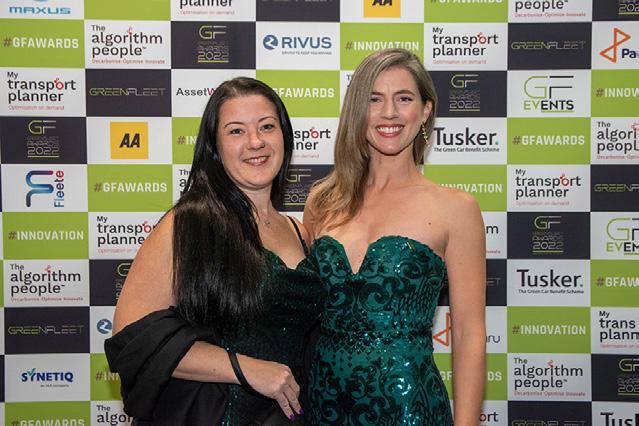
ENTRIES OPEN

TELL US ABOUT YOUR FLEET SUCCESSES

British Motor Museum, Gaydon
Thursday 7th December
RECOGNISING CLEAN FLEET INNOVATION ENTER

To remedy this, Steve believes better communication and collaboration is needed. He explains: “There should certainly be greater collaboration between the local authorities with both public and private sector bodies in their area, in terms of understanding their future requirements, as there appears to be little dialogue (if any) at the moment.
“For example, Grosvenor Leasing is the UK’s largest privately-owned contract hire and fleet management provider in the UK, and we have expertise on electric vehicles and charging infrastructure. We are surprised to have had no contact or dialogue with our local authority and I would assume that this is the same for other local businesses in our area running large volumes of vehicles.
“I also feel the Government needs to pull together a far more cohesive approach to building an EV infrastructure. For example, as of June 15th, 2022, building developers were required to ensure that electric vehicle charging points are now installed within new-build homes, newbuild workplaces, supermarkets, and buildings undergoing major renovations.


“Initiatives such as this are key to supporting local authorities in developing local charging infrastructures, particularly now that an increasing number of commercial vehicle fleets are converting to electric.
“For car drivers, the ability to home charge has underpinned a lot of company car and private motorists’ ability to have an EV, but in the commercial vehicle sector workplace and public charging are going to be key – and the government and local
authorities will need to step up and help, for both the public and private sectors.”
Joined up working
Laura Lancaster from Fleetcor / Allstar raises the issue of fragmentation in the public sector, and a lack of a cohesive approach to EVs is one of the biggest challenge they see at Allstar. She says: “Decarbonisation and sustainability is generally spread over several roles and departments. Budgets fall into different areas of where the need might be, for example with a fleet manager vs facilities and estate who would look after their EV infrastructure.
“This spread creates a couple of issues. The people responsible for one area are not seeing the full picture or have a vested interest elsewhere, for example, deploying different hardware in different sites can mean the end-to-end solutions doesn’t work.
“Expertise in relations to decarbonisation or EV transition is often lacking as they are not accountable for the whole picture and it is not their full time role.
“The creation of sustainability managers across the public sectors would certainly help improve what is happening now and accelerate the transition over the coming years. This role has increased in the corporate private sector, but not from our experience in the public sector.
“The Greener NHS team has assigned Regional Senior Responsible Officers in each of the seven NHS England and NHS Improvement regions to deliver the net zero commitments. These roles cover a variety of areas such as estate and facilities, supply, food, and travel and transport.”
Laura adds that the public sector can use the expertise of companies externally, when planning and commissioning EV infrastructure. And funding support is available through the government, such as the Local Electric Vehicle Infrastructure (LEVI) fund and £50m funding to support and upskill local authorities on public chargepoint planning and tackling local challenges.
Taking on this point about training, Simon Oliver-West from AssetWorks believes it’s important local authorities have funding for training and dedicated staff. Simon says: “Local authorities require financial support to train and employ dedicated EV infrastructure staff. This funding can be used to provide training programs to enhance the knowledge and skills of existing staff or recruit new professionals with expertise in EV infrastructure planning, commissioning, and implementation. Having dedicated staff will ensure efficient management and effective deployment of EV infrastructure projects.
“Likewise Local authorities need financial resources to invest in the installation of EV charging infrastructure. Funding programs or grants specifically aimed at supporting local authorities can help cover the costs associated with infrastructure planning, procurement, installation, and maintenance. This financial assistance will enable local authorities to expand charging networks, establish a robust infrastructure backbone, and accelerate the adoption of EVs within their jurisdictions.”
Collaboration with suppliers and industry partners is also key to EV infrastructure success. Simon explains: “Local authorities should receive support and guidance from EV infrastructure suppliers and industry partners. These stakeholders can offer expertise, technical knowledge, and best practices in designing and deploying charging infrastructure. Collaboration can help local authorities make informed decisions, select suitable technologies and suppliers, and ensure the successful implementation of infrastructure projects.
“What’s more, establishing platforms for sharing best practices and facilitating knowledge exchange among local authorities can be immensely valuable. Regular conferences, and networking events can provide opportunities for authorities to learn from one another’s experiences, discuss challenges, and share strategies. This approach can expedite progress and promote standardisation across different regions.
“Having policy guidance and access to data and research will also help local authorities be better equipped to roll out EV infrastructure effectively. These support mechanisms will help accelerate the transition to electric mobility, foster sustainable transportation systems, and contribute to the decarbonisation of the transport sector,” added Simon. L
www.fleetcor.com / allstarcard.co.uk
www.thegrosvenorgroup.co.uk
www.assetworks.com

A lack of a cohesive approach to electric vehicles is one of the biggest challenges seen in the public sector
Sustainability has been an important part of CitySprint’s strategy for years and the company has now achieved carbon neutral status. Mark Footman, CitySprint’s chief operating officer, shares his advice on creating a more environmentally-friendly fleet

Best-suited for deliveries in metropolitan areas where there are many readily available charging ports, they are quieter than traditional vans, helping to lower noise pollution in cities. Plus, they’ve got the added benefit of saving eight tonnes of greenhouse gas (GHG) emissions a year, making them an obvious choice for businesses.
Finally, bicycles – both manual and electrically-assisted – are a great option for the swift delivery of smaller items in urban areas. Electric motorbikes are also another viable inner-city option, which we use to support our same day and critical healthcare logistics in London. These bikes are ULEZ compliant, save 2.5 tonnes of CO2 annually, have a range of 137 miles and are another invaluable option for quick, zero-emission deliveries in cities and towns across the UK.
‘Sustainability’ – gone are the days when it was just a nice-to-have or another buzzword.
Over the last few years, it’s been propelled in both importance and prioritisation, and has now evolved into something that can no longer be ignored – both by businesses, and also the wider public.
From a business perspective, increasing concern around climate change and companies’ impact on the environment has turned sustainable business practices into a necessity. As expectations on corporate responsibility increase and transparency becomes more important than ever, businesses of all sizes, operating across every industry are recognising the need to act on this now.
This is of particular importance when it comes to the logistics industry. As the UK’s largest same day courier company, we’re incredibly conscious that due to the nature of our business, we have a duty to ensure that our operations are sustainable and that we do all we can to lower our carbon footprint to create an environment that’s fit for the future.
For us, sustainability has been an important part of our strategy for years, and our environmental action now falls under a core pillar of our CSR programme. But with so many potential areas for businesses to focus their attention on, we know it can be tricky to decide where to start. Here we share our advice on the key areas we believe that businesses can, and should, prioritise.
Focus on the fleet
First, eco-friendly fleets are a must to lower carbon emissions. Moving away from diesel and petrol to add more alternatively fuelled
vehicles to fleets is a ‘must’ on the to-dolist of fleet managers up and down the country today. Thankfully, due to advances in technology, the number and variety of zero-emission vehicles that are available for use in business’ fleets, or as part of the supply chain, is growing exponentially. This means there’s something out there to suit every company’s needs and budget. As a business, we have been working hard to grow our green fleet over the last few years. We have been focussed on turning the range of vehicle types we offer into one of our core strengths, and are committed to having a fleet of 250+ green vehicles across the major cities that we operate in by the end of 2025.
For instance, our cargo bike fleet, which we first introduced in 2017, enables us to provide a zero carbon and highly efficient same day delivery service in the capital. The bikes are used to replace small vans and are considerably more nimble, able to navigate peak traffic better, and also reduce noise and air pollution in urban areas. In fact, each cargo bike that replaces a van saves over 4 tonnes of CO2 per year. Cheaper to buy and maintain, cargo bikes hold several benefits. For instance, their lack of emissions means they can operate without being subject to the congestion or ultra-low emissions zones (ULEZ) in London and other cities around the UK. They can also take advantage of dedicated cycle lanes and take shortcuts through streets blocked off to motor traffic and park up close to their destinations. This means that they can complete journeys up to 50 per cent faster than small vans – allowing for couriers to easily drop off and pick up packages. Meanwhile, electric vans are another great zero-emissions option. The latest addition of 40 new electric vans brings our green vehicle fleet to over 180 vehicles, with plans for more e-vans and cargo bikes taking us even closer to our target.
While fleet operations understandably account for the largest proportion of a delivery company’s carbon emissions, there are other things that logistics companies can do across wider business operations to lower their impact on the environment. This can include anything from using renewable energy across office sites and diverting business waste from landfill, all the way to reducing wider business energy consumption. It can also mean launching energy efficiency campaigns across warehouses and service centres to keep an eye on energy consumption – allowing businesses to make small changes as necessary to ensure they are consuming less. These are all things that we as a business prioritise, and that should be a focus for other companies operating within the logistics space if they are truly to embrace sustainability.
The bottom line is that a lowcarbon economy is an essential requirement for all of our futures –both as businesses and as people. We are immensely proud of the sustainability achievements within our logistics operations, which have helped us to achieve carbon neutral status in January 2022, 18 months ahead of schedule. And, looking forwards, these improvements will help ensure our continued success. But there’s no time to become complacent, and there is always more we can do.
With ever-increasing pressure on organisations to take their focus on environmental responsibility to the next level and ensure it runs across all of their operations, businesses both big and small must embrace a ‘can do’ mindset and be willing to invest now for future gain. L
Increasing aroundconcernclimate has sustainableturnedbusiness practices into a necessity

Covering more than 1,200 miles over five days, the EV Rally will visit all capital cities of the UK and Ireland, testing the capabilities of electric vehicles and public charging infrastructure whilst visiting iconic landscapes and innovative clean energy projects

The EV Rally, which takes place 3-7 July 2023, is designed to test the capabilities of electric vehicles and the supporting charging infrastructure, over long distances and deliberately-chosen challenging routes. The aim is to show that electric vehicles are viable and that the charging network is up to the job, as well as highlighting areas for improvement and uncovering any challenges that need to be overcome. Now in its third year, the Rally follows the success of the EV Rally Of Scotland (EVROS) in 2021 and the Great British EV Rally in 2022, which covered the length of Britain, from John O Groats to Lands End. This year the EV Rally, sponsored once more by Lex Autolease, will see teams travel visit all capital cities of the UK and Ireland over five days in a range of different electric vehicles. For the first time, the EV Rally will have electric trucks and motorcycles taking part, as well as electric cars and vans. GREENFLEET’s HGV Manufacturer of the Year, Mercedes-Benz Trucks UK, have had a static presence at the finish lines of the two previous Rally events, but this time will showcase the innovative e-Actros, in motion, for the duration the whole event. There will also be a ferry crossing over to Northern Ireland, to test the Northern and Irish charging infrastructure, which is reported to be more sparse than in other areas.
The EV Rally will cover over 1,200 miles as it travels from Cardiff to Dublin, via London, Edinburgh and Belfast, with designated
stops planned at clean energy projects, iconic sites and charging hubs on route. The first day of the Rally will cover 306 allelectric miles, making it the second longest of the week. It will also be one of busiest in terms of checkpoints and showcases. The start line is in Cardiff and will see teams travel to the first checkpoint in Bristol. Here there will be a Lex Autolease showcase and EV engagement event at the Amphitheatre, supported by Bristol City Leap and Bristol City Council. Teams will then travel to Heathrow to visit the Hertz electric rental site. The next checkpoint is at OVO Wembley Arena for the OVO Energy showcase. Checkpoint four takes place at bp pulse’s EV hub in Kettering for a charge at on one of their ten 300kWh units.
The Rally then travels to the Leicester Tigers stadium for the Europcar showcase, in the shadow on the new Europcar West Stand. Teams finish the day at Nottingham where they can charge overnight thanks to Nottingham City Council’s innovative charging facilities. EV fleet and grid-scale battery storage specialist Zenobē is the Rally’s Power Partner for day one. Zenobē’s ETaaS (Electric Transport-as-a-Service) solution provides fleet operators and local authorities with a full solution for a pay-per-month fee,
including charging infrastructure, battery replacement and award-winning software. This will enable the iconic BEVerage bar to be for the focal point of the Start, with media and refreshment facilities on-board.
Battery logistics, to make the use of the Zenobē solution possible, comes courtesy of Vertellus, the commercial vehicle contract hire specialist from Renault Trucks. They will transport the solution on the back of an all-electric truck and deliver it with zero-emissions at the tailpipe.
The second day of the Rally has been labelled ‘The Beast’, with teams covering 316-miles, making it the longest day.
Heading off from Nottingham, the teams will then visit York’s hyper hubs for the Churchill, Maxus and Speedy showcases. Checkpoint two will be in Sunderland where the Rally’s Charge Card Partner, Paua, will be showcased at the Fastned hub. Here we will also hear about DPD’s electric vehicle fleet innovation at their neighbouring NE depot. The Rally will visit Ore Catapult as the third checkpoint, which is the UK’s leading technology innovation and research centre for offshore renewable energy. Here there will be a showcase of the National Grid’s work in the electric vehicle sphere. Checkpoint four will be on the England-Scotland border, where teams will put two wheels in each country. Day two ends in Edinburgh at East Lothian Council’s Wallyford hub. Day three is the shortest day of the Rally, in terms of mileage. Leaving Edinburgh, teams will be able to head to Kilmarnock for a charge at the innovative Hub at the Athletics Stadium, if they wish, before heading to Cairnryan/Stranraer to hop on the Stena ferry to Belfast.
When in Ireland
Day three ends in an event called EV Rally LIVE!, which will take place at the stunning and iconic Titanic Belfast venue, next to Belfast Harbour. A gathering of Belfast EV dealerships and others from Ireland will be joined by the Teams for an afternoon of networking and collaboration, featuring Mercedes-Benz Trucks, Drivetech, AA, DAFCenex, Webfleet, and Black Horse. Kempower is the Official Charging Partner for EV Rally LIVE! and will be bringing the innovative ‘Movable DC’ unit with them for drivers to utilise to get themselves ready for day four.
Thursday is ‘Game of Thrones Day’, as the Rally takes in a couple of filming locations from the iconic series. The teams leave Belfast and head to the north coast via checkpoint one, Cloughmills, a new Weev mini-hub showcased at the McGuckian Milling Company.
Checkpoint two is Ballintoy, the scene for Pyke, The Iron Islands in Game of Thrones. Checkpoint three is the Giants Causeway, the most visited tourist spot in Northern
willyear,Thisthere be a ferry crossing over to Northern Ireland, to test the Northern and Irish infrastructurecharging
Ireland. Next up is Ballimoney, the Dark Hedges used to shoot the ‘King’s Road’ in Game of Thrones. After that, teams will go to the Battery Bar on the banks of Lough Neagh, before finishing the day in the beautiful town of Newry.
The final day of the 2023 EV Rally will see participants take in the beauty of Ireland, with innovation and clean energy projects as checkpoints.

EasyGo is the Rally’s Charging Partner for the Republic of Ireland and will give teams access to 4,000 public chargers on the EasyGo, ESB e-Cars, and Circle K IONITY networks in Ireland & Northern Ireland.
After crossing the border into the Republic of Ireland, the route takes teams to a newlyopened Rapid Charger hub at Mullingar, before moving on to the Bord Na Mona Mountlucas wind farm. The next checkpoint is Poulapoucha Lake which will provide a stunning backdrop, before heading to Brittas Bay. The final checkpoint is the beautiful town of Wicklow, with the entire rally finishing in Dublin, kindly hosted by Harris Automotive, distributors of Maxus vehicles, where drivers and teams will be treated to a well-deserved BBQ and wrap-up party.
As well as being the headline sponsor for the EV Rally, Lex Autolease is also taking part with its own team – and has a line up of interesting electric vehicles, such as the newto-market Ora Funky Cat, Volkswagen ID Buzz and ID Buzz Cargo, and Jaguar I Pace. And making a surprise appearance at each of the capital cities will be some ground-breaking innovation… Watch this space! Driving for Team Lex will be media presenter and Fair Charge campaigner, Quentin Willson, amongst others.
Maxus has its own team participating and is also the Rally’s Official Logistics Partner, where they will be providing vehicles for the event organisers to get around. Maxus is also hosting the ‘wrap party’ at the finish line, at their HQ in Dublin.
Hertz is joining the Rally with its own team and as the Official Vehicle Partner, where they will be providing two Tesla Model 3s to the event organisers, and two for the media team, driven by EV Café’s Sara Sloman and John Curtis.
The AA is once again the official Roadside Assistance Partner for the 2023 EV Rally, supporting teams if they were to experience a breakdown or puncture. Team AA will also be participating with team Drivetech, who is the event’s Official Driver Training partner, offering tips on getting the most out of an electric vehicle.
Paua enters the Rally with its own team and as the Official Charge Card Partner where they will provide teams with the Paua card and app, which will enable them to find and charge, anywhere on the Paua roaming network. Supporting the charging will be other Partners bp pulse, who have a team, and the Rally will use their RFID cards to access the new ultra-rapid chargers at their new hub in Kettering. And Weev is also giving teams access to their network, when the Rally travels around Northern Ireland.
Bridgestone will be showcasing its electric vehicle tyre technologies during this year’s EV Rally as the event’s Official Tyre Partner, as well as entering with their own team. They’re joined by Webfleet, a Bridgestone company and the Rally’s Official Technology Partner. Webfleet technology will be installed in at least one vehicle per team, monitoring vehicle movement as well as reading power and battery information, giving us a daily m/ kWh reading at the end of each day which will feed into the Rally League Table. Can anyone tip bp pulse off of top spot from 2022?
GREENFLEET’s current Mobility Provider of the Year, Europcar, is taking part in the EV Rally, showcasing its electric vehicle and mobility expertise, with a showcase at their newly-opened Europcar stand at Leicester Tigers RFC stadium.
Team National Grid will once again be taking part in the Rally, with BBC South’s Transport Correspondent Paul Clifton driving for them, supported by daughter Frankie.
Lorna McAtear, National Grid’s head of fleet, leads the team and she will address the UK fleet sector at Ore Catapult, the UK’s leading technology innovation and research centre for offshore renewable energy, on the second day of the Rally. Also participating for the second year will be team OVO, who will be hosting a showcase at the OVO Wembley Arena on day one of the event, before the teams head north for the second half the day. DPD, which has an aim to be the UK’s most sustainable parcel carrier, joins the Rally again this year and will be showcasing their expertise in electric vehicles, notably at their NE Distribution Hub, just outside Sunderland on day two.
GREENFLEET’s Private Sector Fleet Manager of the Year, Aaron Powell from Speedy Asset Services will be driving the Rally on team Speedy, demonstrating the skills the company has thanks to its own electric fleet. Churchill, one of the largest insurers in the UK, will be participating in the Rally
for the first time, and will showcase its offering for electric vehicle drivers.
Team Black Horse Finance, which is part of Lloyds Banking Group, will also be participating and will be promoting a better understanding of the used electric vehicle market.
Helping highlight the capability of electric commercial vehicles are three of the world’s leading manufacturers, each with their own team. Mercedes-Benz Trucks UK will show-off the 200+ mile range of its 27-tonne e-Actros.
Team IVECO is entering the Rally with its newly launched zero-emission van, the eDAILY. IVECO is keen to demonstrate the towing capabilities of the eDAILY by hitching a trailer with a digger to the back and pulling it up one of the steepest streets in the UK.
DAF Trucks and Cenex, who are working together on the DfT-funded Battery Electric Truck Trial (BETT), are teaming up on this year’s Rally. One of the DAF Electric LFs from the trial will be joining the event to test the capabilities of the vehicle on long and challenging journeys. Ember, which runs the UK’s only all-electric intercity bus routes, is the EV Rally Edinburgh Driver Shuttle Partner, and used electric vehicle sales and sourcing experts Next Eco Car is the EV Rally’s Strategic Partner for Ireland. Helping make the event possible are the official hosting, support and media partners. A huge “thanks” to Bristol City Council and Bristol City Leap, Nottingham City Council, Visit Belfast and Tourism NI. The Rally is also partnering with The Electric Vehicle Association Northern Ireland (EVANI). L
To watch the Rally unfold, visit the EV Rally’s social media channels on twitter (@rally_ev) and LinkedIn (EV RALLY), and through the event’s Official Digital Media Partner,Transport + Energy. Live progress can also be seen on ev-rally.co.uk from 03 July.
FURTHER INFORMATION
ev-rally.co.uk
The EV Rally aims to test the capabilities of EVs and charging infrastructure, over long distances and challenging routes
There was a diverse representation of fleets in attendance at the GreenFleet Roundtable in Warrington, all experiencing their own issues on the road to decarbonisation. Event host Kate Armitage reflects on the discussion

GreenFleet’s R2Z Roundtable series took us to Warrington, which was attended by fleets based across the Northwest of England. It was clear that there is tremendous diversity of fleets, from HGV and Commercial vehicles, taxis, as well as council and blue light fleets, and they all face different challenges.
Whilst it may seem obvious, removing underutilised vehicles from the fleet is the quickest way to save money, reduce administration and of course it is one less vehicle that needs to become zero emission.
The Environment Agency has worked hard to reduce the overall fleet size, removing 800 assets from the books.
Catherine Williams, senior project manager at the Environment Agency noted: “The Environment Agency has a big priority to get to net zero by 2030, and we have had to make big changes. From July, the company car list is becoming all electric.”
Similarly Speedy hire are moving to an EV only car list from 2024.
James Brown, from the EST Fleet Support team works with fleets of all sizes to offer a Fleet Review that helps them understand where vehicles can be removed from the fleet and develop a net zero transition plan.
James noted that where “no two fleets are the same”, it is important to analyse
where and how fleet vehicles are being used. Telematics data is an extremely useful tool; from this data it is possible to identify vehicles suitable for electrification today.
Richard Parker, corporate sales manager for Bridgestone Mobility Solutions, the parent company of Webfleet, added: “Webfleet takes the data directly from the CAN bus, and from this it is possible to model the likely energy consumption of the future fleet and determine where and how the vehicles will be charged.” This data can also support energy surveys and form the basis of a transition plan.
Once the vehicles are on fleet, Webfleet is also able to track the battery state of charge and monitor charging activity. The next step for Webfleet is to develop a platform that integrates vehicle data in real time and also provides real time chargepoint data to provide live vehicle charging management and optimisation (of both vehicles and charging hardware). Webfleet is also able to monitor the battery state of health.
As well as the modelling and planning, there was a cautionary note to keep the drivers at the front and centre of the transition.
“Don’t underestimate the driver – they are the ones who will deliver the benefit to the business,” was the message. There is an opportunity to focus on driver well-being which will get the best out of the vehicles (reduced speeding, reduced braking etc) as well as offering training and operational support to ensure the vehicles are charged as planned. Inevitably there will be some resistance from staff who are reluctant to switch from internal combustion engines. The Environment Agency runs focus groups to understand employee needs and concerns.
And Aaron Powell, fleet director at Speedy Services has found a practical approach. He said: “We take our drivers on manufacturer days where they get to experience the vehicles firsthand and expand their knowledge – even the more resistant drivers warm up to driving electric.”
wasThere a diverse range of fleets, from HGVs, vans & taxis, as well as council and blue light fleets, and they all facechallengesdifferent
Charging infrastructure is always a hot topic at the Greenfleet Roundtables, and Warrington was no exception.

As fleets increase their EV penetration – there will be more demands on the EV charging infrastructure, for example increasing the volume of chargepoints, introducing load balancing, and introducing the ability to charge employees for electricity.
As charging needs become more sophisticated, several of our roundtable fleets have learned that all charging solutions are not equal! Hardware reliability, poor aftercare service and limited software services were cited as problems.
Charging infrastructure is expensive and price is a big consideration in the procurement process. “Closed systems” where hardware and software is unique to that solution provider tend to be lower cost. This approach is great when everything is working, however, in the event of a failure the fleet is unable to switch provider and is effectively “locked in” to that solution.
Mick Johnson, sustainability officer for Cheshire Police and Cheshire Fire & Rescue, has experienced a closed system. He said: “Some of the chargers are obsolete and their back-office services and customer services are not good.”
Another of our fleets is also looking for a new solution as the back-office system is not suitable for a large-scale operation with 250 depots.
Open chargepoint protocol (referred to as OCPP 1.6 or 2.0) is a universal communication protocol that allows
interoperability between hardware and software solutions, and importantly allows the fleet the flexibility to switch providers. Whilst OCPP compatibility might come at a price, it effectively futureproofs the growth of the network, and allows solution providers such as Webfleet build to an open platform. Drax has also embedded OCPP throughout their service offering.

Paul George, commercial manager for EV & Infrastructure at Drax Energy Solutions explained: “Infrastructure must be futureproof, it needs to grow and flex with the core business and OCPP allows this”.
Drax also provides a joined-up energy strategy: “Many of our competitors are focused on hardware, at Drax we believe that kWs should be the focus. We install and act as the ChargePoint Operator which includes charging management [ie load balancing] and cost management [such as peak time avoidance]. It is important to quantify the energy requirements, if you understand the kWh’s and idle time we can calculate how much power the chargepoints need. If there is a shortfall in power we can shift the charging to the troughs.”
Whilst Drax Energy Solutions aim to mitigate the need for a network upgrade, ultimately this might be unavoidable. The cost for upgrades is high and varies significantly from site to site. Neil Shacklady of West Lancashire Borough Council, had been quoted £1m to upgrade a substation. Paul George explained that hope was on the horizon for fleets as the way Distribution Network Operators charge for upgrades changed with effect from 1st April this year, which should see connections costs coming down.
Whilst most organisations are coming to grips with Scope 1 emissions, Scope 3 emissions are increasingly hitting the agenda. Scope 3 emissions include indirect emissions from third party suppliers and includes (amongst other things) transportation & distribution and purchased goods & services.
Whilst Scope 3 reporting is not yet mandatory, some of our fleets, including West Lancashire Borough Council and Alder Hey Childrens Hospital, have contracted out services and are now working closely with their partners to ensure contractual obligations to move to net zero.
It was noted that some large organisations with thousands of suppliers will eventually terminate contracts that do not meet their net zero targets; this could be devasting for smaller fleets that have not taken steps to reduce emissions.
The continuing high cost of electricity has had a significant impact on the current total cost of ownership. Aaron Powell also noted that as tax incentives reduce further, the TCO is likely to get worse before it gets better, coupled with the fact that vehicle prices are not coming down fast enough. This challenge is more acute for fleets that capital purchase such as Ready Power, with Richard Burnham noting “upfront cost is a problem”. However, as confidence grows in the technology, some fleets are extending the renewal cycle to break-even. L
GreenFleet’s roundtable at the Duxford Imperial War Museum on 1 June 2023 allowed local fleet operators to share their pain-points and successes regarding fleet decarbonisation
Duxford Imperial War Museum was the impressive setting for GreenFleet’s latest Roundtable, which took place on 1 June 2023. With historic aircraft including Lancaster, Spitfire, Vulcan and Concorde, delegates were considering whether or not their fleets were ready for take-off with their decarbonisation plans.
The roundtable was joined by special guest Naomi Green, managing director of England’s Economic Heartland (EEH) who was keen to understand the challenges and barriers that fleets are facing.

Naomi updated the roundtable on initiatives in Central and Eastern England. EEH is formed as a partnership between the DfT and local authorities, and they engage with businesses to achieve transport targets. This is particularly important in the East of England where carbon emissions from transport is as high as 42 per cent compared to a national average of 28 per cent, due to its rural make up and the high volume of freight travelling to and from multiple ports in the region. Their remit is wide; EEH is not only working on electrification of transport and associated infrastructure, but also looking at mobility hubs and rail freight to reduce emissions.
Whilst several local authorities in the region have received funding from the government’s Local Electric Vehicle Infrastructure Fund (LEVI), our fleets reported that each local authority is pursuing different strategies and procuring in silos. City of Londons transport group manager, Vince Dignam’s experience was that there are too many barriers – particularly if the local authority operates a single framework approach. The introduction of additional clean air zones (CAZ) is another example where more joined up thinking is needed; Chris Ashley, head of policy at the Road Haulage Association (a Trade body representing HGV operators with 8500 members) highlighted that CAZs impose daily charges for diesel vehicles of up to £220 per day but the charging infrastructure to support HGVs is not there.
Bywaters Waste Management Services is adversely affected by the London ULEZ, as their diesel vehicles operate inside the zone, seven days per week. But Anthony Grindrod, head of logistics for Bywaters noted that the congestion charges have helped build the TCO case for electric vehicles. Anthony observed that his cost analysis for an electric caged
tipper versus a diesel equivalent showed a TCO saving of £5k per year.
Focus is shifting to vans and HGVs
Despite the lack of electric vehicles of 4.25t and above, and no transit charging facilities for HGVs, decarbonisation of HGV fleets was a hot topic.
Compared to passenger vehicles, HGVs will require significantly more power, and they will need dedicated charging infrastructure. Cherwell District Council is very aware of this issue and is in the process of moving to new depot premises with more power. Dean Hedger, senior business development manager at Vital EV Solutions is ready for the challenge. He said: “Vital EV offer a range of DC charging solutions for fleets, including the innovative Kempower Charging System that offers a space saving, modular power solution that allows the infrastructure to be scaled up as the fleet grows.” And with over 2,000 EV connections already installed, Vital EV operates the same number of chargepoints as some of the largest public charging networks in the UK. Vital EV also rent out mobile EV chargers (AC and DC), which is ideal for events, or for Operators who are trialing eTrucks. Allowing fleets to get the full charging experience before they invest in the technology.
The question of sharing destination or depot infrastructurecharging for commercial vehicles sparked a discussionlively
And would funded charging infrastructure solutions be of interest? For Kuehne + Nagel, the answer is yes. Mark Waby, procurement category manager likes flat line financing as this sits well with their contract hire model.
The question of collaboration and sharing of destination/depot charging infrastructure for commercial vehicles sparked a lively discussion. Toby Hiles, strategic partnership director at Grid Smarter Cities posed the question: “How realistic is it for fleets to share their infrastructure?”

Neil Durno from Syzygy Consulting works with commercial landlords and real estate owners, and believes that semi-public, bookable charge-points for trucks will play an important role “for 16 hours of the day there is a lot of infrastructure that isn’t being used. However public sector fleets were more hesitant; with security and health & safety being key considerations. There was consensus that access would be closely controlled, with strong collaboration with partner fleets.
As net zero targets grow ever nearer, the question of exemptions crops up more often. Lack of vehicle availability and suitability are very real concerns for fleets that have net zero deadlines of 2030 (or even earlier). Consideration for exemption was specifically requested for specialist vehicles that simply aren’t available today. For example, National Highways operates a fleet of 26t winter gritters that need to be zero emission. National fleet manager, Martin Edgecox, explained: “OZEV have been very quiet on this issue, and [National Highways] have a 2027 deadline for net zero.”
In addition, specialist vehicles are frequently procured on a 10-15 year procurement cycle which means they could possibly be on fleet into the mid 2030s. The RHA, whilst supporting the goal of net zero, agrees that exemptions may be necessary. Linda Grave, founder and CEO at EV Driver, also raised the question of vehicle availability highlighting the recent news that Tesla will no longer be manufacturing the Model S and X in right-hand drive. With a strong influx of vehicles expected from China is must be hoped that other OEMs do not follow Tesla’s lead and withdraw/ deprioritise the right-hand drive market.
Whilst some fleets are not ready to switch to zero emission vehicles, Grid Smarter Cities is working with city-based logistics operators to reduce unnecessary miles. They have teamed up with local authorities to offer safe, bookable, kerbside parking locations in “pop-up” loading/unloading bays. Crucially these parking locations are authority approved and visible to parking enforcement teams. The net result is less
time searching for a suitable parking space, less miles travelled, less local emissions and less risk of getting a penalty charge notice.
With us on the day was Andrew White from Tusker, one of the largest company car and salary sacrifice providers in the UK. With over 20 years’ experience, Tusker offers carbon neutral solutions to both the public and private sector. What was striking was that many of the fleets around the table, including Kuehne + Nagel and Kier Group, are already successfully operating salary sacrifice schemes, and others were actively looking into setting up a scheme. With the continued rollout of clean air zones across the country, many employees may find their old vehicle is not compliant. And for shift workers, such as London Fire Brigade, Clive Robinson noted: “It is not always possible to use public transport in a 24/7/365 operation.”
Salary sacrifice offers an accessible solution to get staff into zero emission vehicles. However, if you are thinking of rolling out a salary sacrifice scheme, don’t wait too long as the very attractive incentives will not last forever. L
As net zero targets grow ever nearer, the question of exemptions crops up more often. Lack of zero-emission vehicle availability and suitability are very real concerns for fleets that have net zero deadlines of 2030, or even earlier.
Model tested: Genesis GV60 Sport Plus
Premium car maker Genesis has arrived in Europe and sets out its ground-up electric vehicle stall with the GV60. Richard Gooding finds the newcomer offers convincing comfort, luxury and technology
Originally the name of a luxurious Hyundai model launched in 2008, the South Korean Genesis brand evolved into a standalone marque under the Hyundai Motor Group in 2015. Its first car, the G90, arrived in 2017. Two further models followed, with the brand’s first European cars arriving in 2021. Genesis’ first dedicated electric car, the GV60, as tested here, arrived in the UK during 2022. Joining the all-electric, but adapted ICE models, Electrified G80 saloon and Electrified GV70 SUV, the GV60 takes advantage of the Hyundai Motor Group’s E-GMP all-electric architecture. Featuring 400V and 800V electrical systems for faster charging and bi-directional power capability, the modular platform also underpins the Hyundai Ioniq 5 and the Kia EV6. However, the GV60 is the most luxurious of the family and is positioned as such, with premium on-board technology and plusher fixtures and fittings.
In keeping with this high-grade image, Genesis has a commitment to hospitality and service, seeking to build relationships with customers, and from 2025, all of the brand’s new vehicles will be all-electric as part of the company’s goal to become carbon net zero by 2035.
The Genesis GV60 is available in three trim levels, with each model grade having a unique powertrain. All are mated to a singlespeed automatic gearbox, and use the same 77.4kWh (gross capacity) lithium-ion battery. The entry rear-wheel drive GV60 Premium has a single 226bhp motor and an official WLTPrated range of up to 321 miles.
The mid-specification GV60 Sport uses a dual motor set-up, and is all-wheel drive. Power is 317bhp, with a range of up to 292 miles, while the range-topping GV60 Sport Plus can officially travel distances of up to 290 miles, despite the massive 483bhp from its dual motor powertrain. Over 546 miles in winter conditions with our Sport Plus-spec test car we averaged 2.6m/kWh, and 211 miles on a full charge.
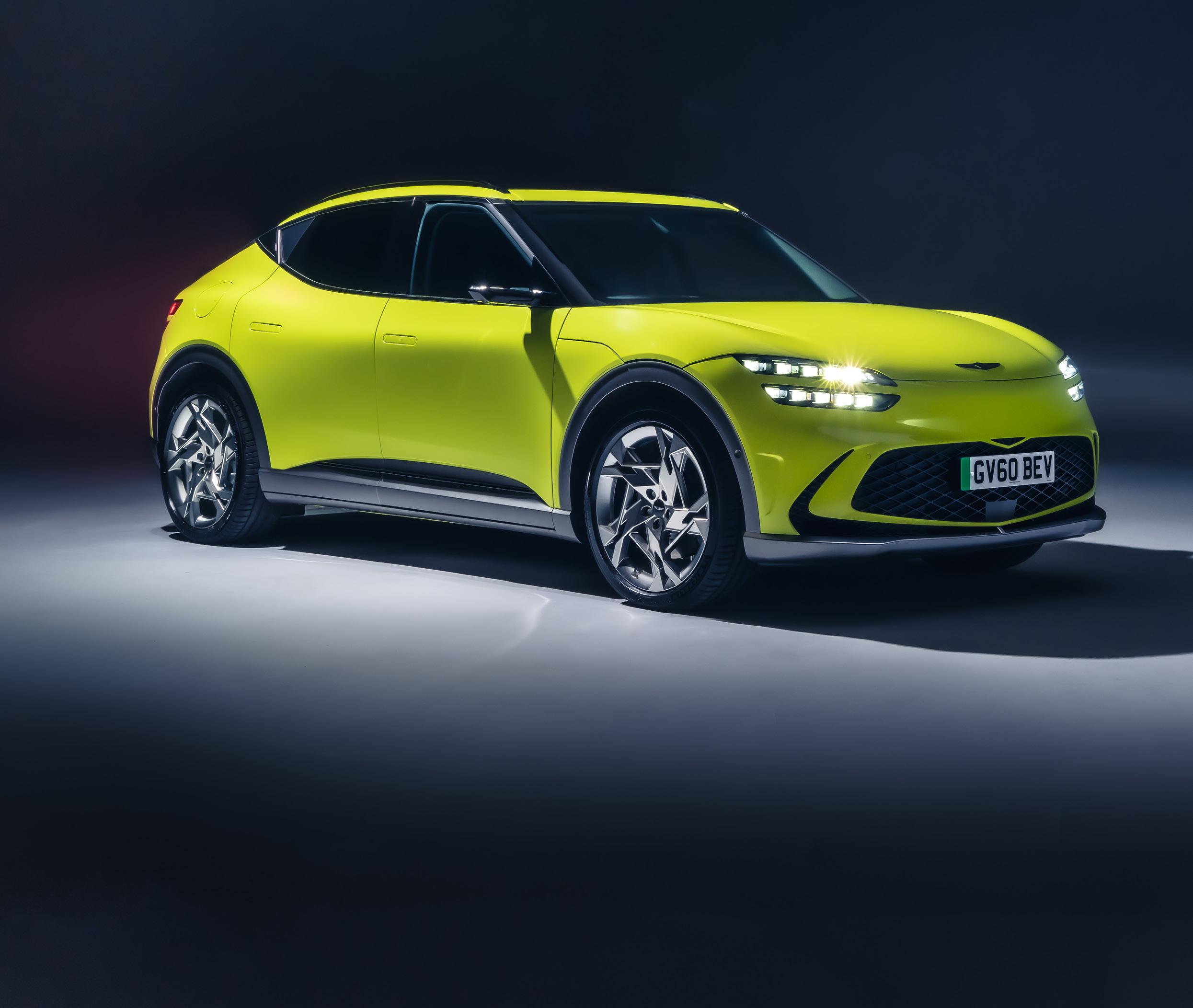
Away from a charging station, the GV60’s ‘i-Pedal’ (Intelligent Pedal) function lets you drive the car with just one pedal. It really works, too, improving efficiency, by maximizing the amount of energy which is harvested when slowing down, feeding it back into the battery. Three levels of brake regeneration are also available, controlled by nicely adjustable and positive-feeling steering wheel-mounted paddle shifters. All-wheel drive models are fitted with the Genesis Disconnector Actuator System (DAS), which smoothly connects or disconnects the front motor from the drive wheels. The DAS works with a Smart Regeneration System 2.0 system, which automatically adjusts the car’s regenerative braking capability depending on traffic data and navigation map information.
How long does it take to charge?
Using E-GMP’s 400V or 800V charging technology, when plugged into an ultra-rapid 240kW charging station, the GV60’s battery can be refilled from 10 to 80 per cent of its capacity in just 18 minutes. A 50kW connection will add 80 per cent capacity in a little over an hour, while an empty to full charge will take around 11 hours on a 7kW supply.
Like its Kia and Hyundai cousins, the Genesis GV60 also features a Vehicle to Load (V2L) function. This £880 option allows the car to be used as a mobile power source thanks to its 3.6kW power output.
How does it drive?
The GV60 may be Genesis’ smallest vehicle, but it shares the same level of avant-garde design as the brand’s larger models. A compact SUV in silhouette, with voluptuous curves and distinctive light bars front and rear, the GV60 gets noticed and has a sense of theatre, and that’s all before you’ve stepped inside. Open the doors by the popout handles, and you’re welcomed by an ambience of luxury and technology.
Centre stage is the ‘Crystal Sphere’, a glass globe which is essentially only a gear selector, but it glows and rotates to reveal the controls when you turn the car on. A little bit of theatre, it has a handy purpose, too; the sphere rotates and hides the gear selector when the car is turned off, so you know that it has no power. The 12.3-inch infotainment system and adjoining driving instrument display hints at the on-board technology on offer, and the metallic finish on the door handles, climate controls and centre console is smart and futuristic, adding to the impression of quality.
Despite weighing around 2,000kg, the Genesis GV60 feels relatively agile on the move with plenty of grip, and its size and weighty steering means it’s easy to place on the road. It’s an enjoyable, comfortable, and relaxing car to drive, and also a very quiet one, thanks to the use of acoustic glass in the windscreen and front doors and foam inserts in the tyres that are claimed to
help reduce the amount of road noise. The Sport Plus dual-motor powertrain on test here serves up 483bhp, which is almost too much, as the car surges ahead when you press the accelerator – on a winding road you’re at the next corner almost before you realise it. ‘Eco Plus’, ‘Normal’ and ‘Sport’ driving modes allow you to tailor the driving experience to exactly how you want it.
Genesis has kept the GV60 model family simple, but as you’d expect from a premiumposition product, it costs more than both its Hyundai and Kia relatives. However, neither – with the exception of the 577bhp Kia EV6 GT – offer the same amount of power as the GV60 Sport Plus. The GV60 also features a more sumptuous and technology filled interior. The Premium is the lowest-priced GV60 at £53,905. Standard equipment includes 19-inch alloy wheels, electrically hidden door handles, auto-dimming rear-view mirror, front and rear parking sensors, heated steering wheel, heated front and rear seats, powered and ventilated front seats, quad-LED headlamps with high beam assist, rear parking camera, smart cruise control, wireless smartphone charger, 12.3inch infotainment system with integrated navigation, Apple CarPlay, Android Auto, voice recognition, and DAB radio, and a 12.3-inch digital instrument cluster.
Moving up to the £58,362 Sport adds 20inch alloy wheels, while the £67,505 Sport Plus gains 21-inch alloy wheels, velourtrimmed headlining, sun visors and door trim, metal ‘Sports’ pedals, Nappa leather trim, electronically controlled suspension, and an electronic limited slip differential. Of course, the price difference on the Sport and Sport Plus over the Premium also


includes the addition of the all-wheel drive powertrain.
A variety of optional packages with features including a Bang & Olufsen audio system, digital side mirrors, and a panoramic sunroof mean you can tailor the GV60 to a more exacting specification. A five-year care plan is also included in the price of every GV60, which includes free pick-up and collection, a courtesy car, as well as overthe-air updates. Dedicated Genesis Personal Assistants also support drivers through their ownership journey.
How much does it cost to tax?
Genesis’ smallest electric vehicle is exempt from UK VED in the first year of registration. After that, at current VED rates, the GV60 incurs no charge. Benefit in Kind (BIK) tax for 2023-2024 is two per cent.
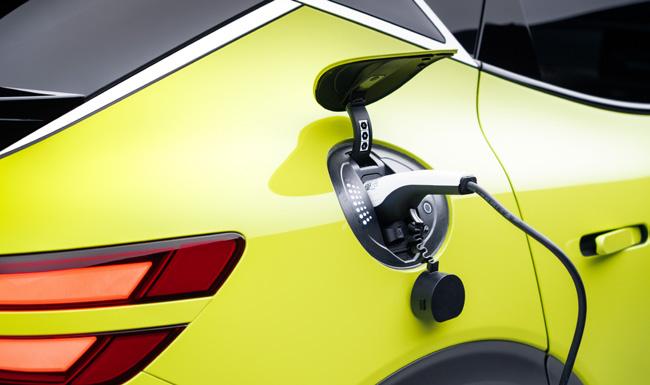
Why does my fleet need one?
Striking looks, a sumptuous interior and a high level of on-board technology are reasons enough to add a GV60 to a private hire fleet, or to choose one from the fleet company car list, but the fact that the smallest Genesis model also drives extremely well makes it a compelling and interesting choice. Add in the progressive customer service commitment and the fact that the Genesis brand itself is backed by one of the most currently innovative automotive groups when it comes to electric vehicle and charging technology, and the GV60 becomes hard to ignore. L
www.genesis.com/uk
The GV60 has been updated for 2023, with enhancements that include world-first facial recognition technology. The Face Connect system forms part of a keyless entry system which also includes fingerprint authentication, and allows drivers to access their car using their face alone.



Using a NIR (Near Infrared) camera in the door pillar and deep-learning image processing controller, Face Connect allows entry without the need for physical or digital keys. The system also automatically pre-loads the user’s profile, meaning the driver’s preferences – such as the position of the driver’s seat and steering wheel – are automatically loaded. Other advances include Digital Key 2.0 – which gives up to three different smartphone users shared access to a GV60 – as well as Plug & Charge capability which allows contactless in-car payment for charging sessions. Developed with Shell Recharge and Hubject, drivers pull up, plug in and charge, with no need for either a payment card or smartphone app.
ENGINE: 226bhp (168kW) electric motor and 77.4kWh lithium-ion battery* / 317bhp (234kW) dual electric motors and 77.4kWh lithium-ion battery** / 483bhp (360kW) dual electric motors and 77.4kWh lithium-ion battery***
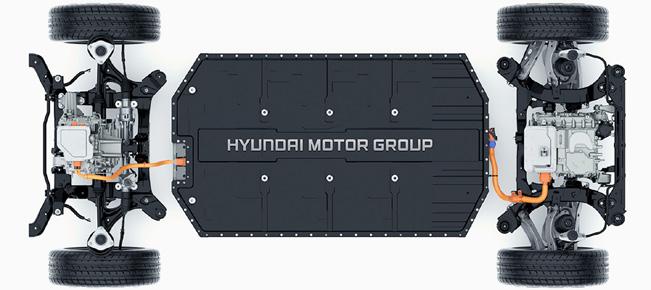
RANGE (WLTP Combined): 321*, 292**, 290*** miles
OFFICIAL EFFICIENCY (WLTP combined): 3.7m/kWh* / 3.3m/kWh** / 3.3m/kWh***
GF TEST EFFICIENCY (combined): 2.6m/kWh
CO2: : 0g/km
VED: £0 first-year, £390 thereafter
BIK: 2%
PRICE (OTR): £53,905-£67,505 (including VAT)
